Home » Anchor Charts » What Is An Opinion Writing Anchor Chart And Where To Find One Online


What Is An Opinion Writing Anchor Chart And Where To Find One Online
Learning how to write academically can pose a challenge. Students need to get familiar with several types of writing, and it can be difficult to keep up with different formats and approaches for each writing style. Younger students especially struggle as they’re new to writing in general and need help with the basic concepts, such as paragraphs and transition words.
An anchor chart is there to help them visualize the information you present, and they can also use it as a reference point in the future. We’ll show you what an opinion writing anchor chart should consist of and where you can download high-quality, ready-to-use anchor charts for your class.
What Is an Opinion Anchor Chart
Unlike informational writing, which presents facts as they are, opinion writing is there to show the author’s point of view on a specific topic and to persuade the reader to agree.
An opinion anchor chart is a teaching tool that helps students get a visual representation of the writing format, as well as some of the writing concepts . The chart also serves as a reminder they can turn to when writing their essay.
A writing anchor chart can focus on different elements of writing, but you should always start with the ones that focus on the structure, such as:
- Introduction anchor chart
- Paragraph anchor chart
- Conclusion anchor chart
- Body paragraph anchor chart
Elements of a Good Opinion Writing Anchor Chart
How exactly would you create an opinion writing anchor chart? Well, again, much like opinion itself, that varies. How you do it depends on your students’ age and cognitive level. Even so, however, the basic anchor principles are the same. How far you go with them can be adapted to suit the grade level.
Differentiate between ‘fact’ and ‘opinion’
Fact and opinion are both important in writing a good opinion piece because they serve different purposes. Facts provide the foundation or support for an opinion. In contrast, opinions are the main idea or position the student tries to express.
It’s important to differentiate between the two so that students understand how to use them effectively in their writing. And, believe it or not, they often struggle to understand the difference.
For example, they may think a statement like “John thinks ice cream is the best food on earth” as an opinion, informing the reader of John’s attitude towards ice cream. However, the fact remains that John thinks ice cream is the best food on earth.
An opinion would be assuming that everyone should feel the same way. For example, “Ice cream is by far the best food on earth”.
An opinion piece without any facts to back it up is likely to be less convincing and less effective. Finding a middle ground between the two is important to write an effective opinion piece.
Show the differences between an opinion piece and a commentary
Students often confuse an opinion piece with a commentary. An opinion piece is a personal response to an issue – like a current event, a school or home rule, or even a new menu in the cafeteria. A commentary, on the other hand, is an unbiased analysis of an issue or topic. But, unlike an opinion piece, a commentary doesn’t offer the writer’s personal take on a subject.
You can illustrate this with a chart or table that shows the differences between opinion and commentary. For example, in the “Opinion” column, you might write, “Opinion is personal,” ; whereas in the “Commentary” column, you could write, “With commentary, it’s nothing personal” .
Show them how to organize their ideas with an essay outline
Create a simple visual representation of the framework – or essay outline. An opinion piece can’t be written off the bat. Students will need to construct an opinion piece. A standard essay outline lists the main points covered in the piece. So, first, pick a topic.
Alternatively, each student can pick their own topic, and you can all work on your anchor charts together. Next, create a mind map of the beginning, middle, and end of the “story” or opinion that needs to be put across: i.e., opening statement, argument, and conclusion.
Demonstrate persuasive writing
An opinion piece is written to persuade the reader to share the writer’s point of view on a topic. To write an opinion piece, you must develop the three key components from the previous point above a strong opening statement, an argument (or supporting paragraphs), and a concluding paragraph.
The first paragraph should grab readers’ attention and offer a detailed topic summary . The second paragraph should feature one or more supporting examples to help prove your point. The final section should conclude the topic and summarize the main points of your opinion piece.
Writing Hooks Anchor Chart From Sassy Savvy Simple Teaching
Opinion writing hooks anchor charts are the first charts you should introduce to your students when it comes to actual writing. Use charts to show them what a hook is and how they can use it to pull the reader in.
Since writing a hook can be difficult for students, try to provide them with colorful examples and leave empty spaces for them to fill out. This will help them get a visual aid of hooks and start their creative process.
You can have an anchor chart that focuses on one or all of the most common hook types:
- Interesting fact
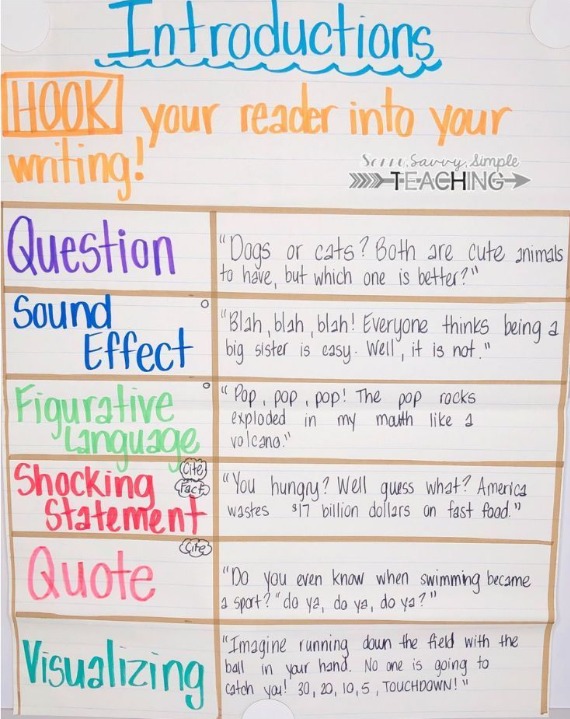
Opinion Transition Words Anchor Chart From Weebly
Show the students how they can link sentences and paragraphs together with transition words. This is a powerful tool that many students (especially younger ones) neglect, and they can get used to using it by having a chart by their side. This chart can help them come up with the appropriate transition word. As time goes by, using transition words will become more natural, and they won’t have to refer to the anchor chart every time.
You can use different designs here, depending on how you want them to use transition words. For example, you can use a stoplight design and give examples for three types of transition words:
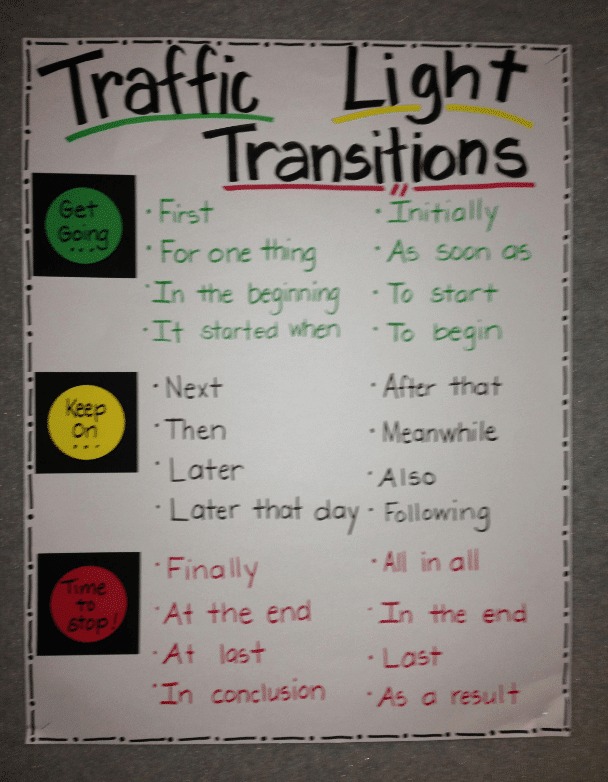
Opinion Reasons Anchor Charts—OREO From Our Global Classroom
Opinion Reasons anchor charts are great as they teach students about the structure of a good opinion writing piece. It shows how they’re supposed to present their thoughts and how to reinforce them with logic. Having a memorable acronym is only a bonus.
Use this chart to introduce the OREO formula and show students how to present their ideas. The formula is as follows:
- Opinion —Introduce your opinion about a given topic
- Reason —Provide information or logical explanations that support your opinion
- Examples —Give details and real-life scenarios that support your opinion
- Opinion —State your opinion again to affirm your point of view
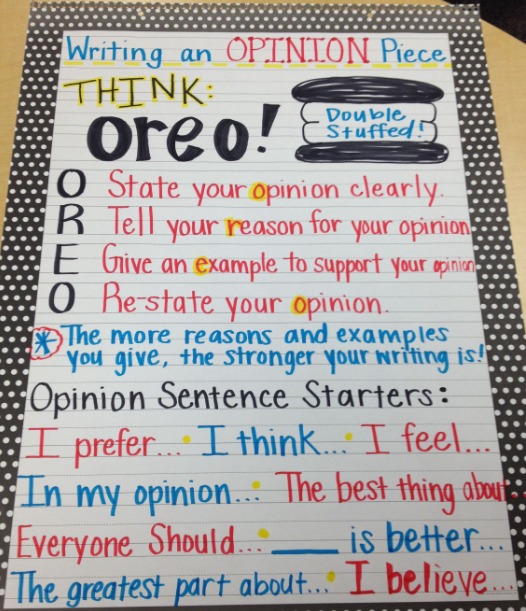
Download High-Quality Opinion Writing Anchor Charts From Teach Simple
While writing anchor charts can be straightforward, and you can even get your students to make them, they still need to be carefully thought out. How do you make sure you use all the necessary information and the easy-to-remember definitions? Planning an anchor chart can be difficult, and it can take you hours, especially if you’re new to it.
If you don’t have the time (or the will) to come up with your own for every class you plan, you can sign up for Teach Simple and find thousands of lesson plans , anchor charts, and other materials related to ELA and writing in particular.
Every product listed on Teach Simple is made by a teacher exclusively, and other teachers review each material to ensure it meets various standards and quality requirements. This way, you can rest assured you’ll enrich your classes with high-quality anchor charts made by people who know what it takes to teach students different types of writing.
Different ways to use anchor charts to teach opinion writing
Let’s look at how anchor charts can be used differently to highlight opinion writing.
Scaffolding From Lucky Little Learners
Students who are not proficient in each element of scaffolding writing can become overwhelmed quickly, so instruction in these elements is crucial. However, breaking them down into bite-sized portions will make them much more manageable.
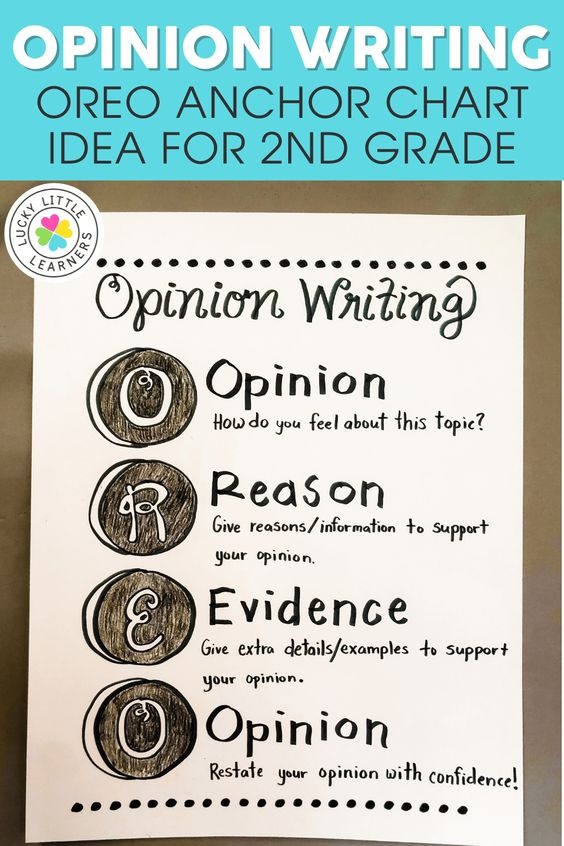
Fact Vs. Opinion sorting From Lucky Little Learners
Sorting facts and opinions is something that should be done in groups. What better way to get your students to express their opinions? And you can build the anchor chart together, making it far more relevant to the students. You could use many techniques to practice this skill with your team. For example, ask your students to jot down one thing they know about broccoli on a post-it note and stick it to the board. The students will typically write that it’s green, tasty, gross, healthy, and a vegetable. Once the notes are placed on the board, discuss whether a claim is a fact or an opinion and categorize it.
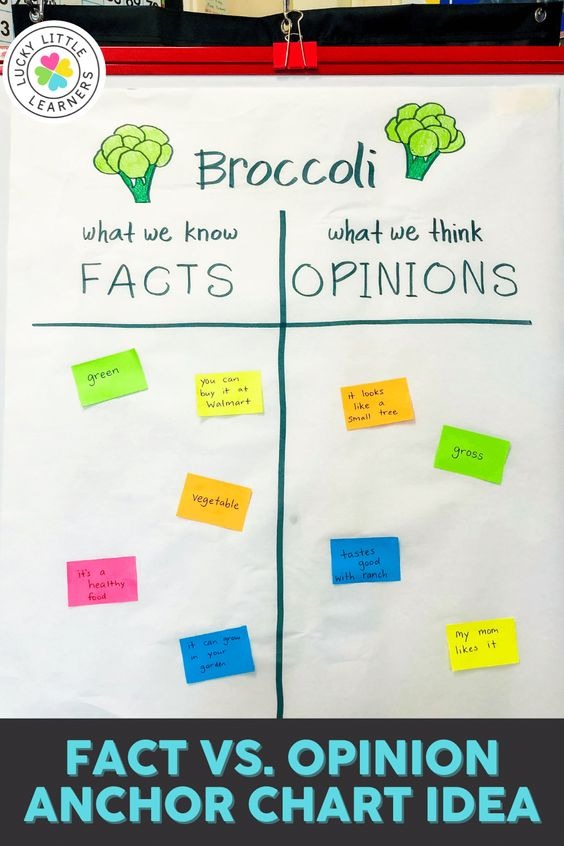
Display examples
It is essential to show students what various levels of mastery look like. Showing your students examples of completed writing can help them visualize expectations and encourage them to keep working and growing.
Model good opinion writing from Mrs. Winter’s Bliss
To illustrate how you would use a graphic organizer to plan your writing, model it for your students. At the beginning of your writing, introduce your perspective with a topic sentence. Next, list your supporting arguments. Finish with a final sentence that reiterates your viewpoint. As a group, identify the topic sentence, the supporting reasons, and the conclusion in your shared writing.
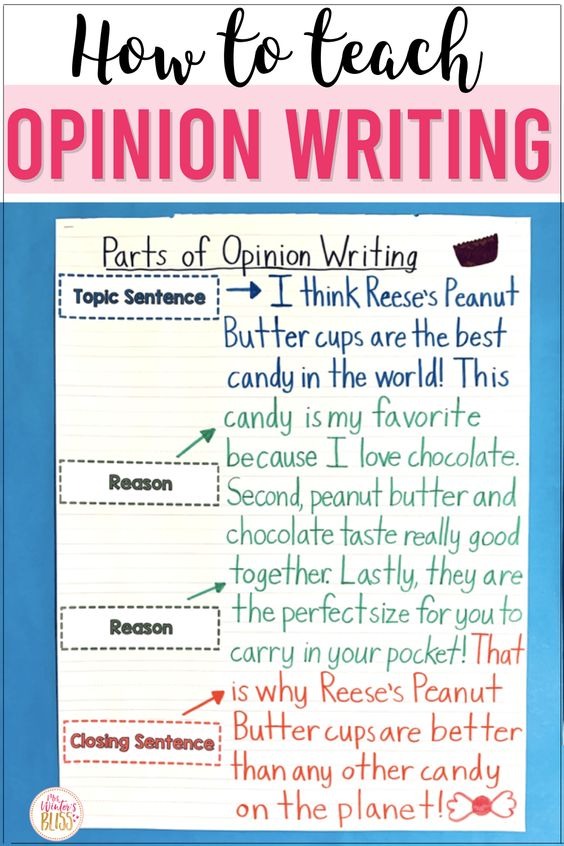
Opinion Essay Structure From Wild About Fifth
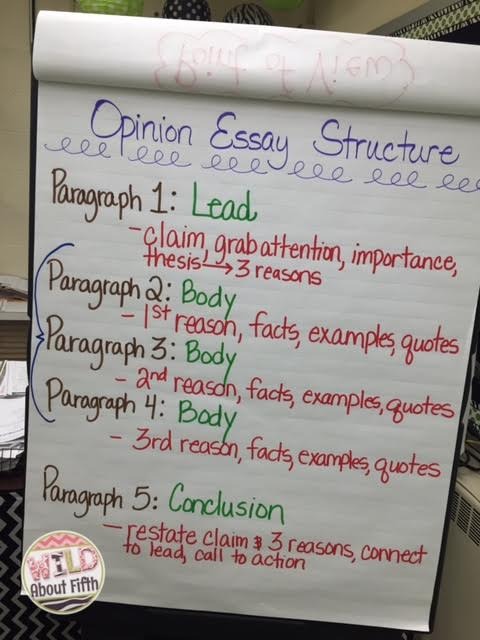
Opinion writing resources from Teach Simple
Looking for an opinion writing chart that covers all the bases? Here is everything you need. All these charts and resources support the elements you need to get started to ensure your students understand how to express their opinion in writing.
Opinion writing anchor chart By First in Line
These charts give students the O.R.E.O. acronym to remember and can be placed on a display board or in their notebooks.
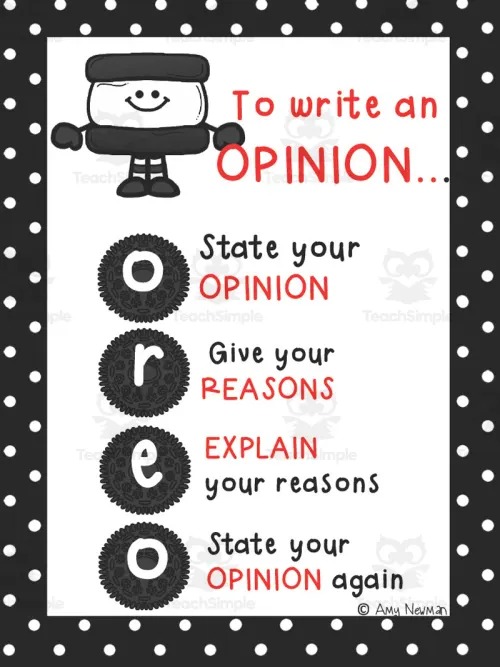
Digital graphic organizers By Teach Me This
This resource is jam-packed with digital opinion writing templates that will give your students multiple opportunities to practice this comprehension strategy.
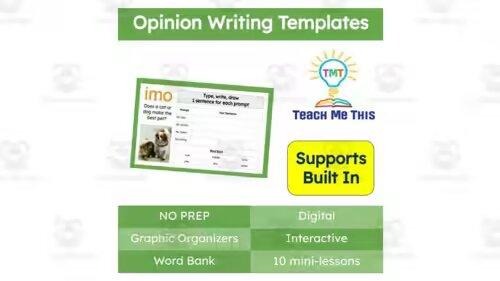
“What do you think?” opinion writing activity By Have Fun Teaching
This graphic organizer is perfect for younger students and guides them every step of the way.
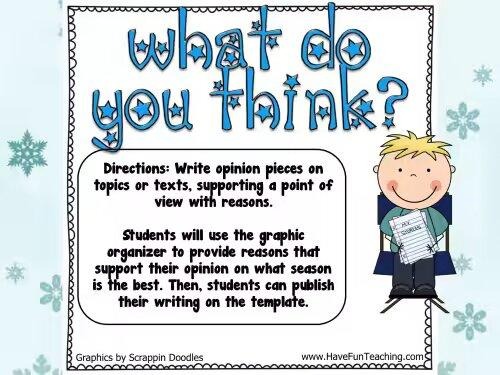
“Would you rather…?” By Aunt Minty’s Education Place
This resource is compiled with 20 high-interest opinion/persuasive writing activities designed for students in Grades K-3.
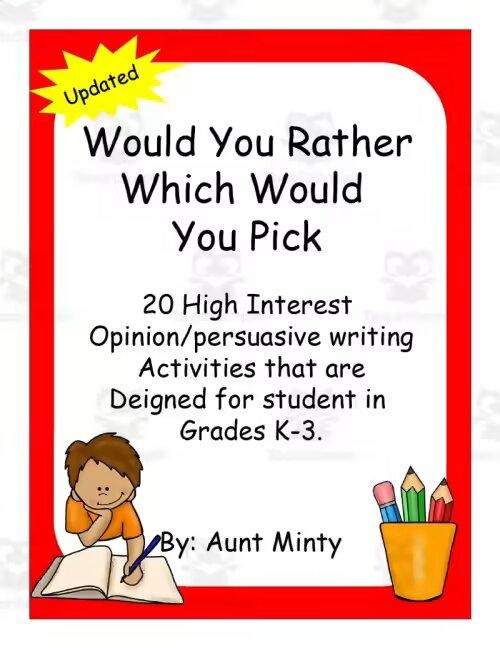
Opinion writing unit – analyze two accounts of the same topic
This resource lets students practice analyzing multiple versions of the same issue and integrating their learning into a complete opinion response.
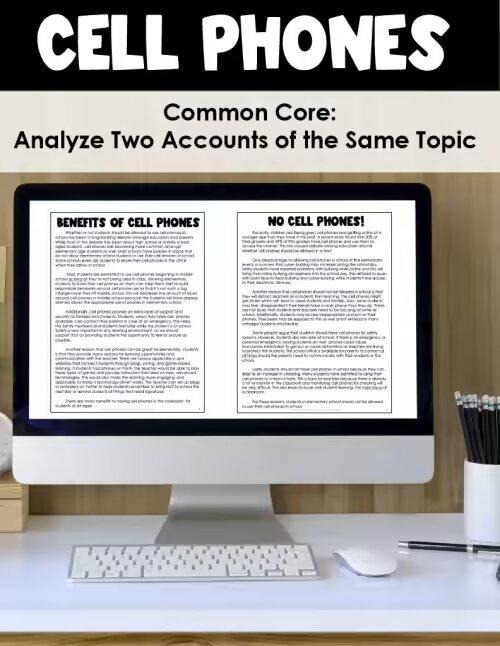
Opinion writing unit: paid for chores By Life Beyond the Gradebook
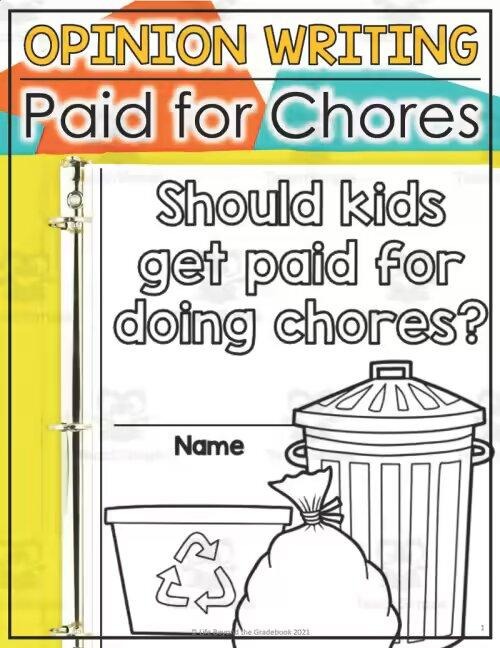
Two texts are included in this resource, one in support of the topic, and one against the topic. The students should use these texts to find evidence that supports their own opinion and use it in their essays.
Opinion writing Anchor Charts from Teachers
Opinion transitions from art of it.
Sentence starters and transition examples can ease students in and take some of the pressure off.
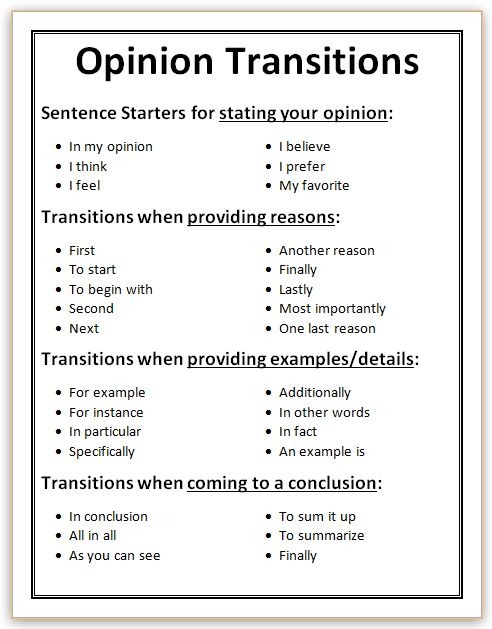
Opinion writing planner From Art Of It
This prewriting graphic organizer will guide students through their planning process.
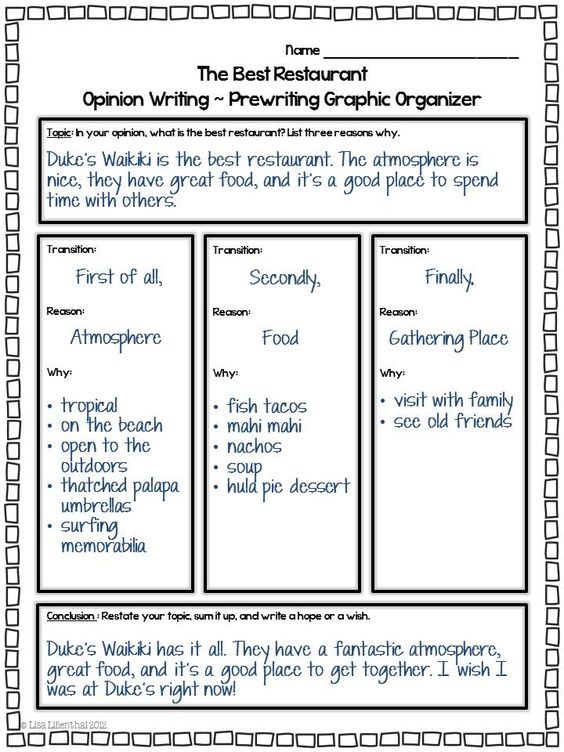
Opinion writing checklist From Worksheetplace
This checklist is great for helping students check their work to ensure they have covered everything.
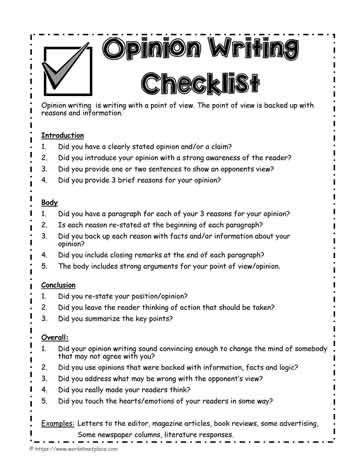
Having a wide variety of opinion anchor charts available can help break down a topic into smaller chunks and make it easier to understand. In addition, using visual aids like anchor charts helps make the lessons more memorable and engaging. Finally, when students need a confidence boost, they are usually grateful to have something to refer so they can move forward independently.
Check out our top pick for anchor charts for writing :
- Opinion Writing Anchor Chart
- Writing With a Purpose Anchor Chart
- Anchor Charts for Writing
- Appeal to Senses Anchor Chart
- Poetry Writing | Anchor Charts & Visuals
- Anchor Charts Professional Development
- Fact and Opinion Anchor Chart
- Idioms Anchor Chart
- Homophones Anchor Chart
- Writing a Beginning, Middle, and End
- Verbs Anchor Chart
- Nonfiction vs. Fiction Comparison Anchor Chart
- Teaching Plot Anchor Chart
- Author’s Claims Anchor Chart
Share Article:
Download unlimited teaching resources, join free today, teach simple.
The team behind Teach Simple is a small but dedicated group who are passionate about education and making a positive impact on the lives of teachers and students.
We have a lot of interesting articles and educational resources from a wide variety of authors and teaching professionals.
What Is A Theme Anchor Chart And Where To Get Them Online
Informational writing anchor charts—what types there are.
Last Updated on August 30, 2023 by Teach Simple
Ready to receive FREE resources and engaging teaching ideas?
Your Thrifty Co-Teacher
A Teaching Blog
Opinion Writing Anchor Charts for Upper Elementary
January 16, 2021 by Cristy

Teaching new writers how to gather evidence and plan for text-based writing can be challenging. Transitioning them over to actually writing the essay where they must weave those ideas into a well developed and organized essay is just as big of a task. Below, are some ways you can use opinion writing anchor charts to give 4th and 5th grade students tangible examples of how to make their writing focused, well-supported, and engaging.

1. Opinion Writing Hooks
Once students have a plan of action for their writing, introducing a writing “hook” is a natural place to begin when starting instruction of actually writing the essay.
Start off by explaining that a “hook” captures the reader’s interest and makes them want to continue to read. It should relate to and tightly tie into the topic that will be discussed.
Introduce the four most commonly used (and easiest to use) hooks.
- Interesting Fact

2. Introductory Paragraph
Now that students know how they will start their essay, they are ready to complete their introductory paragraph. For this quick lesson, tell students to start with their hook. Then, specify that writers need to include words from the prompt. This helps the reader know what the paper will be about and also helps the writer stay focused as they write. They can also include a preview to their answers in this paragraph.

3. Introduce the Components of Body Paragraphs
Body paragraphs are the heart of the essay. This is where the writer needs to provide the reasons they agree or disagree with the prompt. They also need to support their reasons with text evidence and elaborations.
Many teachers are familiar with the acronym R.A.C.E. as a form of responding to a question. I like to use the acronym T.R.A.C.E. because it reminds the writer to use transitions within the essay and within the paragraphs.
During this step of instruction, it is beneficial to break down the acronym for your students. Introduce what each letter stands for. Explain that this is not a specific formula, but a guide that shows what should be included throughout the paragraph.
As you explain each letter, have students create an anchor chart and color code the text . Later in the writing process, this will help them identify what they are doing well and what they may need to add more of in their paragraphs.

4. Writing the Body Paragraphs
Now that you’ve discussed the components of a body paragraph and have taught students how to color code each letter, it’s time to model the writing.
Write the first body paragraph along with your students. It is best to write it on the board where they can all see it. Have students copy the sentences as you write them. Think aloud as you write. This will help students understand why you are including and excluding certain information.
Don’t be afraid to make mistakes and cross words or phrases out. Have students copy a few of these errors too. This will allow them to see that they can change their mind or fix errors.
Once you have completed the paragraph, color code the text. This will allow students to visually see the components of a body paragraph.

5. Introduce Types of Elaborations
Once students have seen you model a body paragraph, focus on the elaboration within the paragraph.
Introduce the four types of elaborations most frequently used within text-based writing.
- Definition: tells the meaning of an unfamiliar word
- Anecdote: a short story inserted into the text
- Example: provides specific cases, samples, or instances
- Scenario: a description of a possible event
Provide Students with Opportunities to Practice
Although this is not a specific step in teaching writing, it is included because it is important to give students multiple opportunities to practice.
Depending on your students, you may want to focus on certain areas of a text-based writing lesson when you offer opportunities to practice. Do not feel the need to have students complete an entire prompt each time they write, especially at the start of the school year.
Starting off with an overview, then moving on to certain parts before moving on to a complete essay can be a great way to scaffold this process for students. Offering students the opportunity to refer back to their opinion writing anchor charts as they write is also a key component to helping them become proficient writers.
Looking for More Support with Opinion Writing Anchor Charts?
Hopefully, these tips have helped you organize your beginning opinion writing lessons.
If you would like the opinion writing anchor charts discussed, you can click on the image to take a closer look.


Persuasive Writing Unit of Study
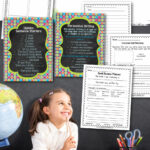
This free persuasive writing unit of study is designed to fit into your 1st, 2nd or 3rd grade writing workshop.
Download this persuasive writing unit of study to help you plan an engaging and effective unit in your classroom.
This unit contains anchor charts, graphic organizers and lessons to help you create the perfect unit for your students.
This is another free resource for teachers and homeschool families from The Curriculum Corner.
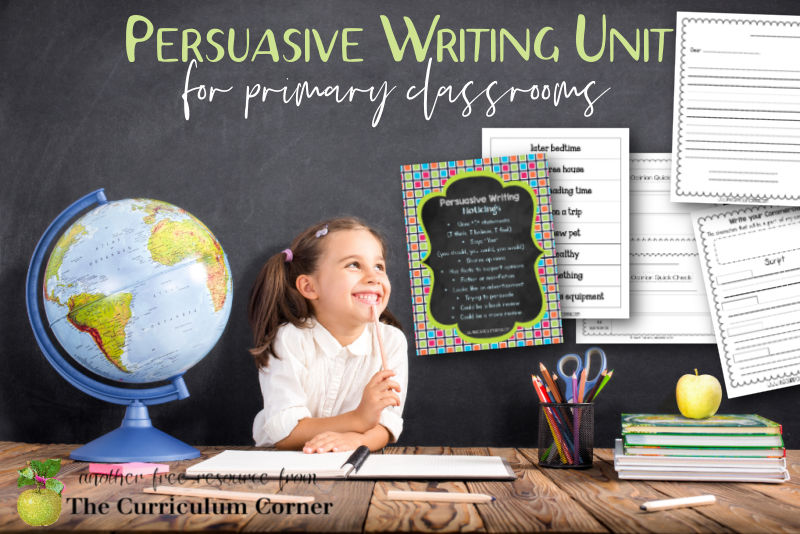
This persuasive writing unit of study is just what you need to make your planning easier.
Within this newly updated unit, you will find both colorful and black and white anchor charts. This will help you conserve color ink if needed.
The unit contains anchor charts, graphic organizers & more. All resources are provided in a single PDF download.
What is persuasive writing?
Persuasive writing can be an important part of the primary writing curriculum. It encourages students to use their opinions and knowledge to influence others.
Persuasive writing can be thought of as extension of opinion writing. It differs in that the author’s opinion is followed by reasons for the opinion along with an attempt to persuade the reader.
This unit on teaching children to write persuasive pieces was designed with second grade in mind. However, you will find many mini-lessons that can be used for other grade levels.
This unit was written with the help of Cathy’s student teachers (Joel Larrison, Kellie Wood and Amanda Rush.)
A writing workshop typically begins with a 10 to 15 minutes mini-lesson.
Some of the ideas for lessons below could run beyond the 15 minutes. Because of this, you might choose to spread some of the lessons over multiple days.
You will want to reinforce some of your mini-lessons with reviews or follow-ups as needed. The types of writing being done by students will often times require more than one day to complete.
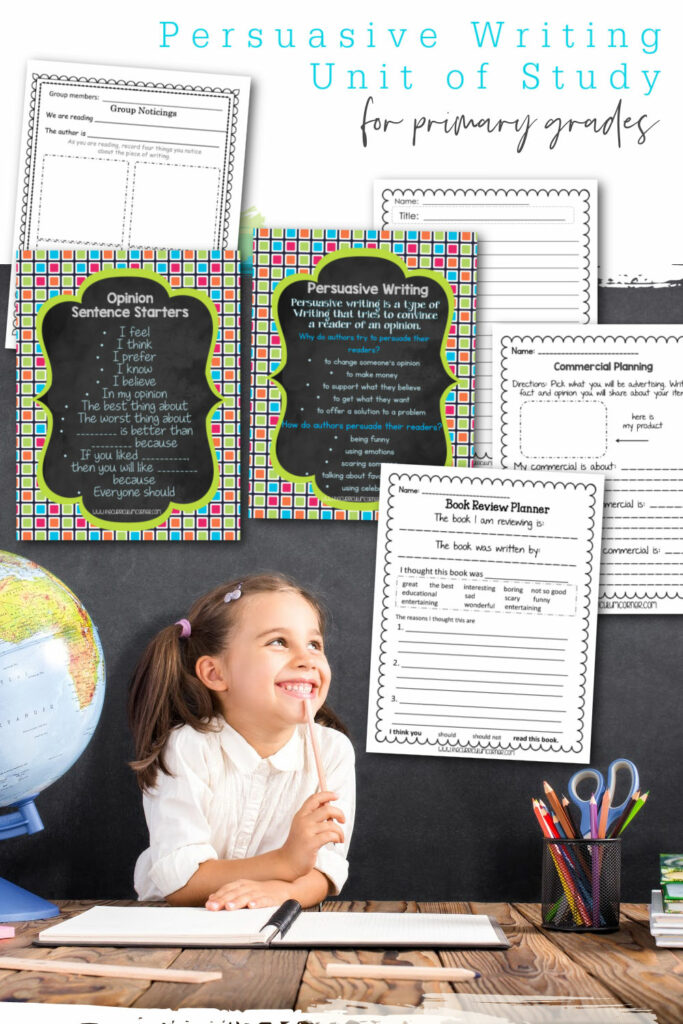
Persuasive Writing Mini-Lessons
- The first two days of this unit are designed to expose children to different types of persuasive writing. It is important to have a good stack of mentor texts so children can explore the unique features of this type of writing. This stack is different than other mentor stacks you might have created for other units because not all of your texts will be books. You can add book & movie reviews and other types of persuasive writing that fit.
- We start many of our units by having our students “notice” various things about certain types of texts.
- In this case give small groups of two or three students two mentor texts.
- Then provide post-it notes and ask them to “notice” features of the writing by recording their observations on the post-its. You may also choose to use our Group Noticings graphic organizer.
- After students have time to explore, gather them together and share their observations. Discuss the texts and their similarities.
- You can use the blank chart so that you can create your own anchor chart with your students. You will find an already completed anchor chart to help you start.
What is Persuasion?
- Read aloud the book I Wanna Iguana by Karen Kaufman Orloff.
- After reading, discuss the term “persuade” and what it means. Talk about how the main character in the story is trying to persuade another character in some way.
- Use the Persuasive Text Story Map to show what is happening in the book. After completing the story map, discuss the Persuasive Writing Anchor Chart.

Choosing Persuasive Language
- Younger students often need help choosing the correct persuasive language.
- A lesson where you create an anchor chart with powerful word choices for this type of writing can be helpful. We have an anchor chart with some possibilities you can introduce. Your students might also think of new words to add to it.
Supporting Our Opinions
- Read the book aloud and then complete the Persuasive Text Story Map (same as from lesson 2) as a class.
- Next, give the students a chance to create their own supporting details for a persuasive piece. Together, choose a topic of high interest. Perhaps it could be “Why the class should have a longer recess” or “Why teachers should give less homework”.
- Fill out the Persuasive Planner with the class to help guide children in creating strong supporting details for the opinion topic.
- Doing this will also give the students a model for planning when they begin to create their own opinion pieces.
Writing a Persuasive Paragraph
- Model how to write a persuasive paragraph using the Persuasive Planner the class created in lesson 4.
- You can show and discuss the Opinion Sentence Starters anchor chart and use it to help you begin your writing in front of the class.
- Be sure to “think aloud” as you write in front of the class. This will help them understand how you are using your planner and making writing choices as you go.
- Next, show the students the list of 16 persuasive writing topics provided. You can have each choose their own topic from the list of ideas (or think of a new one).
- Pass out Persuasive Writing Planners to everyone. Students can begin by writing their opinion topic at the top, and thinking of three supporting details to add below. Once students have completed their planner, they can begin to write their own persuasive paragraph. This is where the previous modeling comes in handy! You will find a lined page in the download for students to use. Some students might need more guidance so be sure to conference with students during independent writing.
Introduction to Persuasive Letters
- For this lesson it is best to read aloud a book that has persuasive letters within the story itself.
- Discuss with students what the animals want in the book and the supporting arguments they give.
- As a class, pick a topic that students could use to write a letter. They might write to the principal, cafe manager or other important adult in the building.
- Write a class letter trying to persuade the adult of the class’ opinion. (A letter writing template has been provided if you wish to use it.)
- For example, students might try to argue that they should be allowed to watch a movie because of their hard work and good behavior. Another idea is persuading the cafe that they should serve a new favorite food.
- As the class participates in this guided writing activity, be sure to point out punctuation that letters should have.
Writing a Persuasive Letter
- Begin this lesson by gathering students to reread and discuss the letter that was written in lesson 6.
- Once again, emphasize the importance of supporting their opinions with details. Also remember to review punctuation.
- Next begin brainstorming topics and audiences to whom they might write a persuasive letter.
- As students are thinking, briefly meet with each one to discuss what topic and audience they choose to write for. They should be working to complete the Persuasive Writing Planner.
- As they finish their planners, have students meet with peers to talk about their supporting opinions before they begin to write their actual letters.
- We have provided a simple letter template if you would like for your students to use one.
Introduction to Commercials & Ads
- Your students will probably love this lesson! Start by sharing some of your favorite commercials with your class from your computer screen, SmartBoard, or tablets.
- After each commercial, discuss what was being advertised, as well as one fact and one opinion from each commercial.
- Discuss the purpose of commercials and ads – to persuade people to purchase a product or service. Emphasize that commercials and ads are most definitely a form of persuasive writing in our every day life.
- We have created a recording page, Finding Facts & Opinions in Commercials” to accompany this lesson. Students can record their ideas as they work if you would like.
Planning a Class Commercial & Ad
- For this lesson you will need to bring in a product that you think the students will enjoy creating a commercial and advertisement for. (The crazier the product the more fun the class will have!)
- Show your students the product and discuss its characteristics and strengths.
- Together fill out the Commercial Advertisement Planning pages to fit the specifics of the product you brought in.
- We have provided two types of planners for each one so that you can choose which works best.
- These will serve as the model for students to plan their own commercials or advertisements in the next lesson.
Writing Individual Commercials or Ads
- Using the planning pages from lesson 9, model for or explain to the students how you would like them to write their own commercials or design their advertisements.
- Refer back to the Words for Persuasive Writing anchor chart to remind students of persuasive language they will can use in their writing. Also be sure to include specifics about opinions and facts within the advertisements that you want them to include.
- Then, have students choose one form of persuasive writing they would like to do – a commercial or an advertisement. You might even decide to have them work with partners.
- Have students brainstorm products (or give them an extra day to bring something in) and fill out their respective planners.
- We have created pages where students can draft a commercial script and/or design an ad. After a few days of writing and working, have students act out their commercials or create a hallway display of the advertisements they create.
- Discuss the persuasive nature of the ads and point out the facts and opinions contained in each.
Introduction to Writing a Book Review
- Another form of persuasive writing is a book review. Students will attempt to persuade their peers to read a particular book they have enjoyed.
- First spend some time reading book reviews as a class. You will find some great examples (mentor texts) of book reviews here: Spaghetti Book Reviews .
- Read some aloud with the entire class and also provide some time for students to read a few with partners. Gather students to discuss the purpose of a book review – persuading others to read or not to read a particular book.
- Spend time discussing the importance of providing strong opinions and reasons so that the piece will truly persuade the reader.
Writing a Class Book Review
- Use a book that you have already read aloud to the class to model for students how to fill out the Book Review Planner.
- Once the class has completed the planner together, model how you would like for them to format their actual book reviews.
- There are many formats that book reviews can take – written reports, brochures, posters…even the commercials and ads your students learned in the previous lessons.
- You make the decision on the format for the book reviews based on the standards you are teaching. If you choose a writing-only format, we have several different styles of papers to choose from at the end of the download.
- Again, be sure to “think aloud” as you are writing so students know what to include and why it is important. This also allows you to model good grammar, punctuation and other rules (book titles, indenting, etc).
Writing Individual Book Reviews
- Students now have the tools and knowledge to write their own book reviews.
- After choosing and reading a book they would like to write a review on, have students fill out Book Review Planners.
- You may want to choose one format for all of the students to use to write their reviews. Or you can show several options (models) and let students use their own creativity to write the book review.
Celebration
We always suggest some type of writing celebration at the ends of writing units of study. The celebration for the persuasive writing unit can simply be a gathering of people for students to share their writing with. Or, you could have students present their commercials, ads and book reviews. The intent is to make students feel proud of their learning and the writing process.
You can download this free unit of study here:
Writing Unit Download
Below we have included links to our favorite books to use when teaching a persuasive writing unit of study (contains affiliate links)
Looking for other free resources to add to your study? Try these:
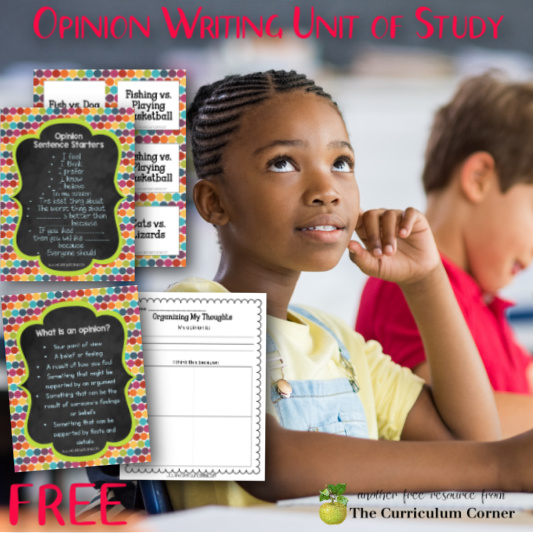
As with all of our resources, The Curriculum Corner creates these for free classroom use. Our products may not be sold. You may print and copy for your personal classroom use. These are also great for home school families!
You may not modify and resell in any form. Please let us know if you have any questions.
Focus on: Video Games - The Curriculum Corner 4-5-6
Tuesday 27th of August 2019
[…] You might also like: Persuasive Writing […]
Planning a Dynamic Writing Workshop - The Curriculum Corner 123
Wednesday 11th of July 2018
[…] Persuasive Writing […]
Friday 27th of May 2016
I love it~ do you think this will be appropriate for 3rd grade?
Jill & Cathy
Tuesday 31st of May 2016
Hi Kathy! We try to create most of our resources so that they can be adapted for the range of grades the website is intended to address, so our immediate answer is yes, but of course it will depend on your particular students and their capabilities - as with all of our resources. Hope you are able to use some of the persuasive unit ideas & resources in your 3rd grade class! If you have other ideas, don't hesitate to email us!
Sunday 1st of November 2015
Your site is amazing! I could spend the entire week on this site and still not get through all the amazing units! I am currently working on Persuasive writing with my students and your resources have been beneficial. Unfortunately I am unable to see the list of mentor texts that you mentioned were at the bottom of the page. All I can see is an advertisement. Any possible way you can send me your list of texts? Thank you!
Monday 8th of February 2016
Hi Lou! We had some troubles with Amazon links, but are working on getting them all fixed. If you click on the book titles within the post text it should take you to the Amazon links of the books we suggest. Sorry about that!
4th Grade Emergency Sub Plans
Friday 13th of February 2015
[…] so you can write in your own prompt. (You will find additional persuasive writing resources here: Persuasive Writing Unit of Study. This post includes an anchor chart and list of words used in persuasive […]
Persuasion Map
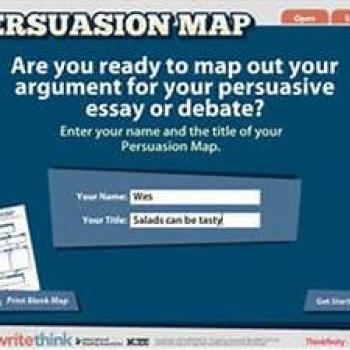
About this Interactive
Related resources.
The Persuasion Map is an interactive graphic organizer that enables students to map out their arguments for a persuasive essay or debate. Students begin by determining their goal or thesis. They then identify three reasons to support their argument, and three facts or examples to validate each reason. The map graphic in the upper right-hand corner allows students to move around the map, instead of having to work in a linear fashion. The finished map can be saved, e-mailed, or printed.
- Student Interactives
- Strategy Guides
- Calendar Activities
- Lesson Plans
The Essay Map is an interactive graphic organizer that enables students to organize and outline their ideas for an informational, definitional, or descriptive essay.
This Strategy Guide describes the processes involved in composing and producing audio files that are published online as podcasts.
This strategy guide explains the writing process and offers practical methods for applying it in your classroom to help students become proficient writers.
Through a classroom game and resource handouts, students learn about the techniques used in persuasive oral arguments and apply them to independent persuasive writing activities.
Students analyze rhetorical strategies in online editorials, building knowledge of strategies and awareness of local and national issues. This lesson teaches students connections between subject, writer, and audience and how rhetorical strategies are used in everyday writing.
Students examine books, selected from the American Library Association Challenged/Banned Books list, and write persuasive pieces expressing their views about what should be done with the books at their school.
Students will research a local issue, and then write letters to two different audiences, asking readers to take a related action or adopt a specific position on the issue.
- Print this resource
Explore Resources by Grade
- Kindergarten K
- Skip to main content
Not So Wimpy Teacher
The Not So WImpy Teacher creates resources for busy teachers in grades 2-5 who are looking to deliver engaging and meaningful lessons without overwhelm and chaos.
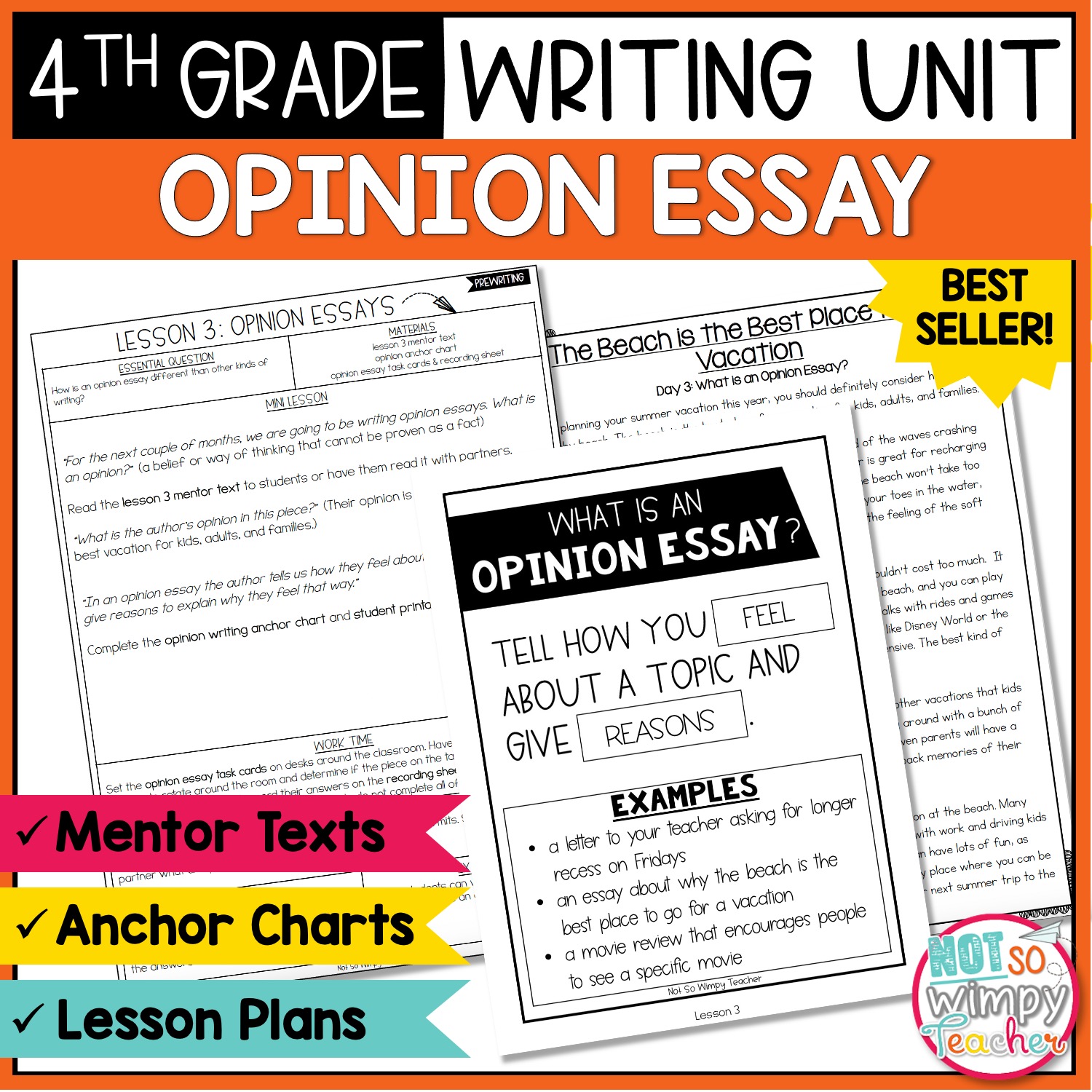
Opinion Writing Unit FOURTH GRADE
Grade Level: 4th Grade
My fourth grade opinion writing unit includes 8 weeks of done-for-you writing lessons about how to write a strong opinion essay . This unit contains detailed lesson plans, mentor texts, anchor charts, student writing tasks, and rubrics –everything you need to be a capable, confident writing teacher with students who love to write.
Also available in the following bundles

More about this resource
If teaching writing has ever made you cry, weep, tear out your hair, question your existence, or binge-watch reality television—because it’s just that frustrating and overwhelming—this writing unit is perfect for you.
If your students dread writing time more than meatloaf in the school cafeteria…this writing bundle is perfect for them, too.
Teaching writing can be tough. Teachers tell me that their district-provided writing curriculum is:
- too complicated
Or worse, they don’t have any curriculum at all. Yikes!
But my fourth grade opinion writing unit makes teaching writing easy . It takes all the guesswork out of teaching writing and gives you the tools you need to teach engaging and effective writing lessons without breaking a sweat.
This resource is part of a money-saving writing writing bundle! Click HERE to see the bundle!
The ready-to-use lessons and activities in this opinion writing unit will teach your students h ow to use supporting facts, reasons, and examples, consider opposing viewpoints, write topic and concluding sentences, and structure paragraphs . And all you have to do is print and teach . The lesson plans are that simple. Seriously.
Student-friendly mentor texts make it easy to provide illustrative examples of new writing skills. You don’t have to waste your time and money hunting down just the right book. Focused mini lessons and daily writing tasks simplify the writing process helping ALL students, even reluctant writers, experience success. Preprinted anchor charts make it easy to model new skills and engage in shared writing without wasting valuable time.
And best of all, my opinion writing unit makes writing fun for ALL your students – from reluctant writers to excited writers . The Student Success Path helps you identify where your students are on their writing journey and plan just-right lessons and interventions . Short, focused lessons keep students engaged. Simple, direct writing tasks help kids develop confidence. Conference materials, including outlines and topic cards, you can use to guide small group discussion make it easy for you to differentiate lessons.
Choice empowers students to write about things they care about and makes them more invested in their writing. And that’s a big deal because students who enjoy writing and get lots of practice perform better on standardized testing.
Plus, these materials are easy-to-use . Everything is organized in folders to help you find just what you need. A Quick Start Guide makes it simple to get started and provides tips on how to prep materials for long-term use.
The 2-week Starting Writing Workshop mini-unit will help you start your writing instruction on the right foot. Detailed teacher directions show you exactly how to use all the resources and activities.
How Our Writing Bundles are Aligned with the Science of Reading :
- Structured writing routine: Our writing bundle is organized into 4 genres. Each 8-week unit is carefully structured, beginning with foundational skills before moving into more advanced skills. Students are taught a systematic approach to writing including: brainstorming, drafting, revising, editing, and publishing.
- Explicit instruction: Daily lessons begin with explicit instruction including access to examples via mentor texts, modeling, and directed practice. Each skill is broken down into bite-size pieces so that students can learn one skill at a time. Students practice skills independently, working on one sentence or paragraph at a time.
- Differentiation: Writing is differentiated through small group instruction that provides reteaching, additional practice, and support at appropriate levels.
- Daily opportunities to write: The majority of the writing lesson is reserved for independent writing time, providing students with large blocks of time to write and practice skills every day.
- Demonstrates the connection between reading and writing: Mentor texts provide concrete examples of writing skills and allow children to experiment with and apply sophisticated skills and language in their own writing. In addition, constructing their own writing pieces helps students recognize, connect, and understand these strategies when reading.
What’s Included:
- Detailed teacher directions and suggestions for simple implementation
- Unit-at-a-glance calendar for each unit
- 7 exclusive videos walking you through how to get the most out of these writing units
- 40 days of lesson plans that include guiding questions, materials, mini lessons, student work tasks, student share tasks, intervention, and several extension activities
- 14 original mentor text passages
- 24 opinion writing task cards (identifying whether a topic is an opinion)
- 24 opinion writing prompts task cards
- 11 teacher anchor charts (blank and filled in versions)
- Student anchor charts and printable for writing notebooks
- Conference and goal tracking forms
- Writing grades tracking forms
- List of 10 additional mentor text books (Remember, using them is optional, because I’ve included all the mentor texts you need)
- 6 different writing publishing papers
- Student writing notebook cover and dividers
- Teacher notebook covers and binder spines
- Multiple ideas for author share celebration
- DIGITAL writing notebooks on Google Slides
- Conferencing Materials – Conference outlines, a sample conference, and topic cards you can use to guide your small-group conferences
- Student Success Path – Identify where your students are on their writing journey
- Starting Writing Workshop Bonus – Two weeks of writing lesson plans to help build stamina and set your students up for writing success

Skills Covered:
Students learn h ow to craft a strong opinion essay using supporting facts, reasons, and examples, topic and concluding sentences, and structured paragraphs. Lessons include:
- Setting goals
- What is an opinion essay?
- Generating essay ideas
- Writing strong opinion statements
- Writing a lead
- Supporting your opinion with reasons
- Considering your audience
- Consider opposing opinions
- Supporting your opinion with examples
- Topic and concluding sentences
- Word choice
- Transitions
- Writing a conclusion
- Generating deeper topics (research based)
How to Use it in the Classroom:
A typical day of writing:.
I recommend you set aside thirty minutes for writing each day (or more if you have it). Check out the sample schedules below. Each day follows the same plan:
- Mini-Lesson (8-10 minutes): The day kicks off with a mini-lesson to teach a particular skill. The mini-lesson uses mentor text (remember, it’s included in the unit) and anchor charts. For the teacher version of the anchor charts, you can project and fill them out with the class, or print and display them in your classroom. The student versions are smaller so they can fill them out and keep them in their writing notebooks for reference.
- Work Time (18-20 minutes) : Students will apply the skill they just learned into their writing each day. The included writing tasks make it crystal-clear what to do during independent writing time–for you and your students. By the end of the unit, they will have completed two full masterpieces and many other independent writings.
- Share Time (2 minutes) : Students are encouraged to share a piece of their writing with a partner or with the entire class. This makes writing more meaningful to kids and holds them accountable.
Organization Made Easy:
- The opinion writing unit is organized into multiple folders and files so it’s easy for you to find what you need.
- A 40-day daily schedule so you know exactly what to teach each day.
- Detailed daily lesson plans make teaching writing easy.
Differentiation:
There are many ways to differentiate writing assignments:
- Use the Student Success Path to identify where students are on their writing journey and use the suggested interventions to modify lessons.
- These daily writing prompts are intentionally short and sweet so that all students, even those below grade level, can feel successful. Most tasks can be completed in 1-2 sentences.
- More advanced writers can write longer responses, or work on a second masterpiece if they finish early.
- Students can complete fewer task cards or work with a partner; you can also provide support to students as they work on task cards.
- The process for teaching writing includes group conferencing time. These groups should be based on ability so that you can individualize your instruction to meet the specific needs of the group. Use the topic cards to guide your small group lessons.
Why you’ll love this writing unit:
- You’ll save hours of prepping and planning time. The daily lesson plans are easy to implement. All you have to do is print and teach.
- Mentor texts are included. You do not need to hunt down or purchase any additional books! (Unless you want to. Far be it from me to stand between a teacher and new books.)
- Digital anchor charts project onto your white board-so you don’t have to be Picasso or Renoir to anchor your kids in the lesson.
- Pre-printed student anchor charts make it easy for students to follow along without having to write every word and draw complicated diagrams.
- Digital student notebooks are perfect for 1:1 classrooms and a great way to save paper.
- These lessons work for all students, even students below grade level.
- Task cards incorporate movement, reinforce concepts, and make learning fun. Daily share time encourages students to take pride in their writing.
- Direct writing instruction provides a solid foundation of writing skills that leads to increased test scores.
- Aligned with the Science of Reading.
*****************************
More Fourth Grade Writing Units:
Personal Narrative for Fourth Grade
Informational Writing for Fourth Grade
Fiction Narrative for Fourth Grade
Writing Units for Other Grade Levels:
Second Grade Writing Bundle
Third Grade Writing Bundle
Fifth Grade Writing Bundle
Frequently Asked
Yes. I also have personal narrative , informational essay , and fiction narrative writing units available.
This opinion writing unit is available for grade 4. I also have opinion writing units available for grades two , three , and five .
I prefer composition notebooks because they are sturdy and easy to use and store. But other teachers have used spiral bound notebooks or three-ring binders.
Yes. These writing lessons are based on Common Core standards.
The lessons for consecutive grade levels are very similar because the standards are similar. The biggest difference is that the reading level on the mentor text passages is modified to meet the specific grade level. Other differences include new examples in the lesson plans and anchor charts and new task cards. It is generally fine to use units that are one level above or below grade level. You might want to select the lower grade level to ensure that the mentor texts are easier for students to read.
Each unit includes eight weeks of materials. I recommend spending 30-45 on writing each day. The lesson takes 8-10 minutes and the rest of the time would be used for independent writing.
Students complete two masterpieces in each unit. But they may work on additional pieces if they finish daily assignments early.
My writing units are a standalone curriculum. They are not based on or aligned with any other curriculum. However, they are based on the writing standards. My curriculum is organized into units of study and formatted in the workshop model and hundreds of teachers have successfully used my writing units with their district provided curriculum.
My writing units are a standalone curriculum. They are not based on or aligned with any other curriculum. With that being said, I have hundreds of teachers who have chosen to use my units as a supplement to their Lucy curriculum because it is more manageable and engaging for students.
You May Also Enjoy These Resources
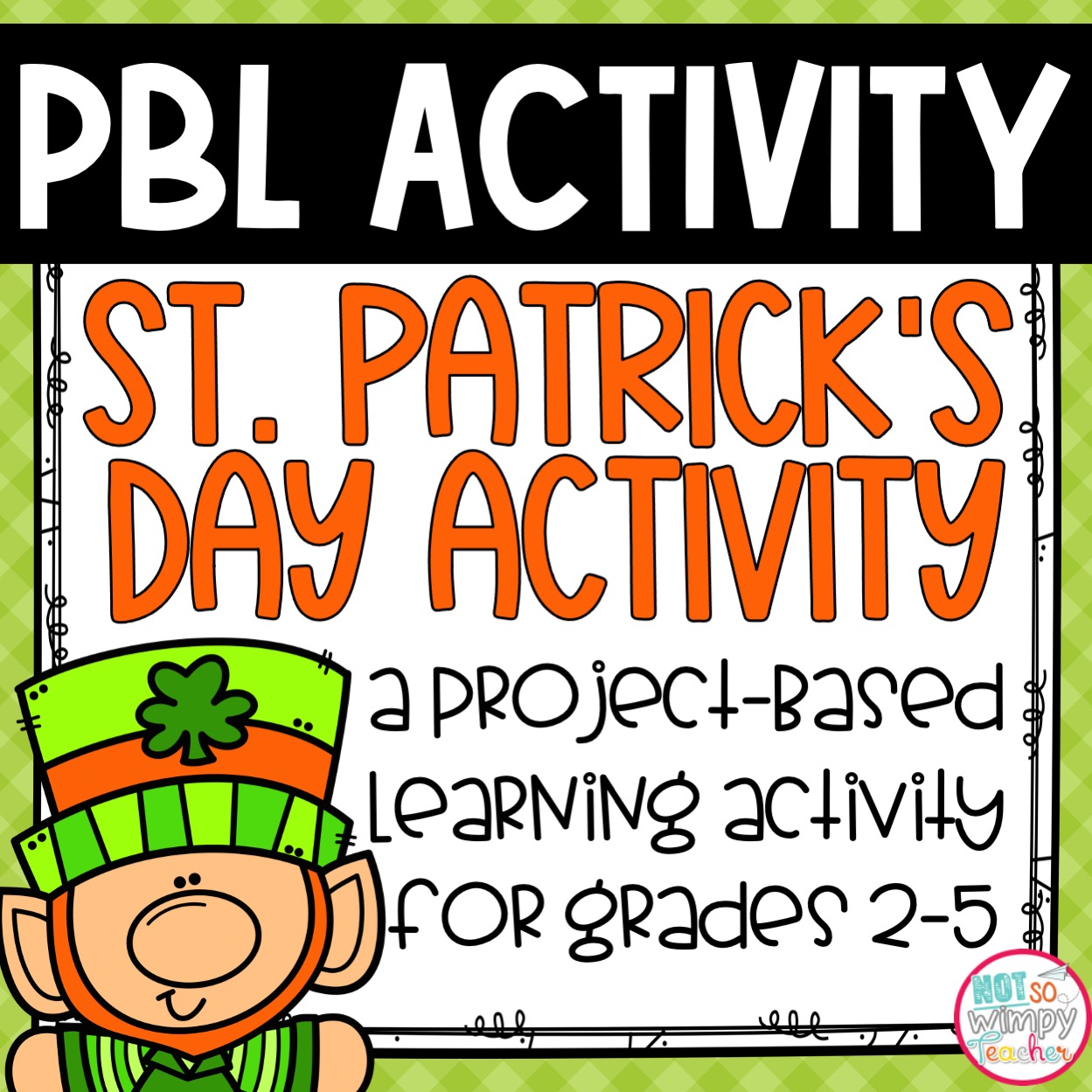
- Grades 6-12
- School Leaders
FREE Poetry Worksheet Bundle! Perfect for National Poetry Month.
40 Must-Have Anchor Charts for Teaching Writing of All Kinds
Writing information and inspiration for all!
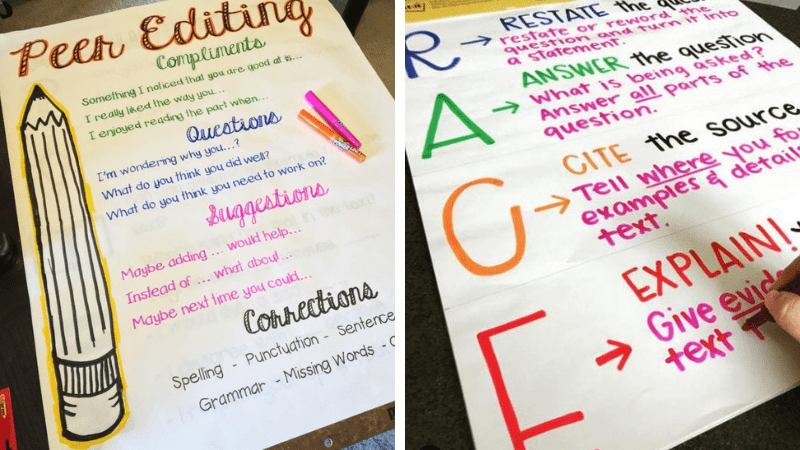
When it comes to writing, many kids struggle to get their ideas down on paper. That’s why we’ve rounded up all the best writing anchor charts, to help your students master narrative, transitions, punctuation, editing, theme, and so much more! Try some of these ideas in your classroom to give your kids the writing support they need.
1. Why Writers Write
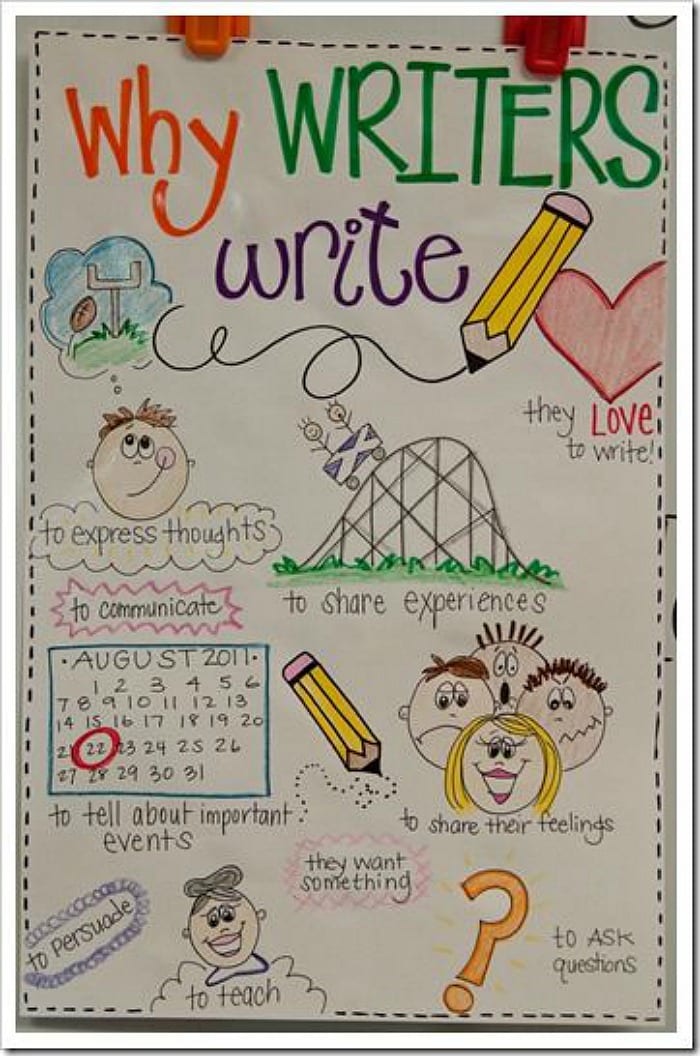
First and second graders will draw inspiration from this fun-filled anchor chart about why we write. Make this chart applicable to older students by expanding on each aspect with a specific audience or goal. “To share experiences” can become “to share experiences with friends, in a postcard, or with readers of a memoir.”
Source: Cara Carroll
2. Expanding Sentences
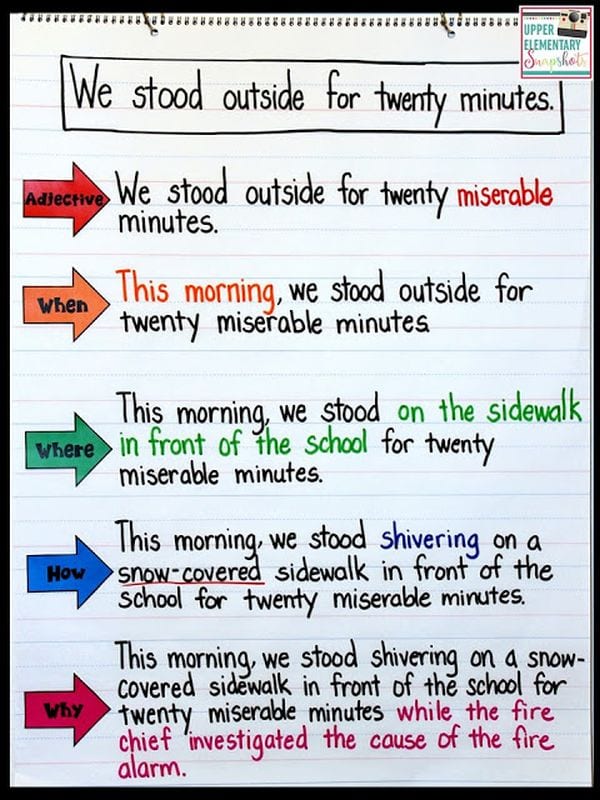
Show students how a simple sentence can become a real powerhouse by exploring when, where, how, and why, along with adding adjectives. So powerful!
Source: Upper Elementary Snapshots/Expanding Sentences
3. Personal Narrative
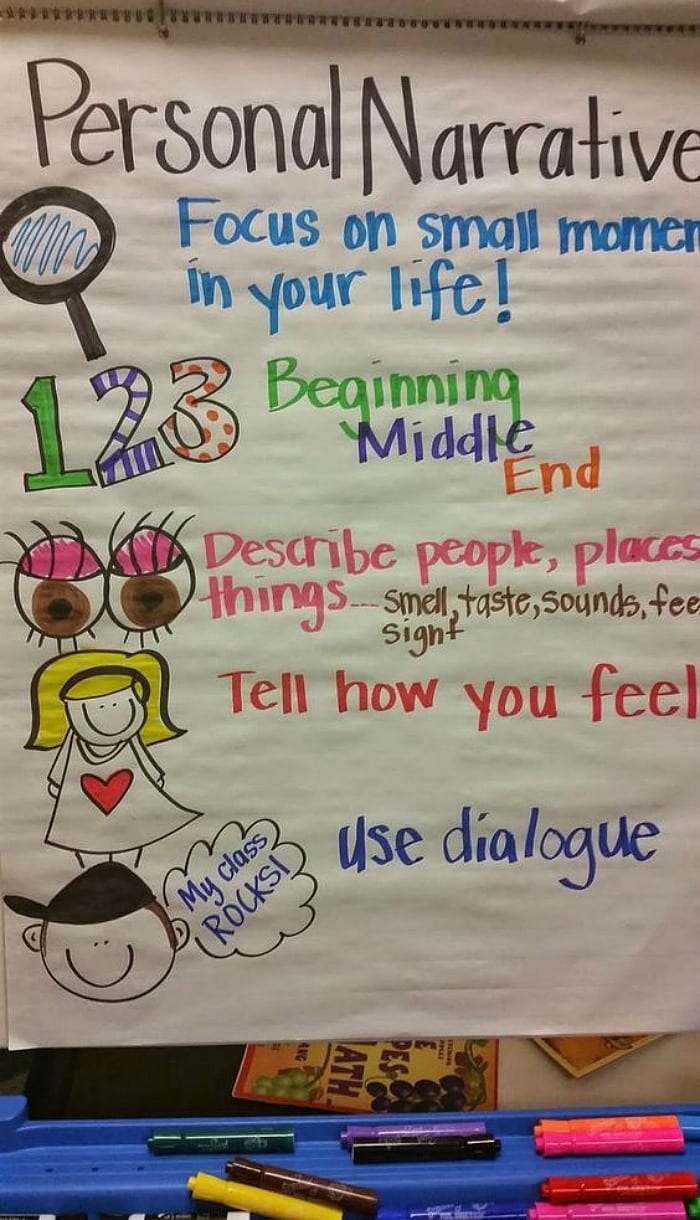
Personal narrative is a style that all students practice in elementary school, and writing anchor charts can help keep them on track. Visit the link below for great worksheets to use with your students to prepare them to write their personal narratives.
Source: Rachel’s Reflections
4. Hook Your Reader
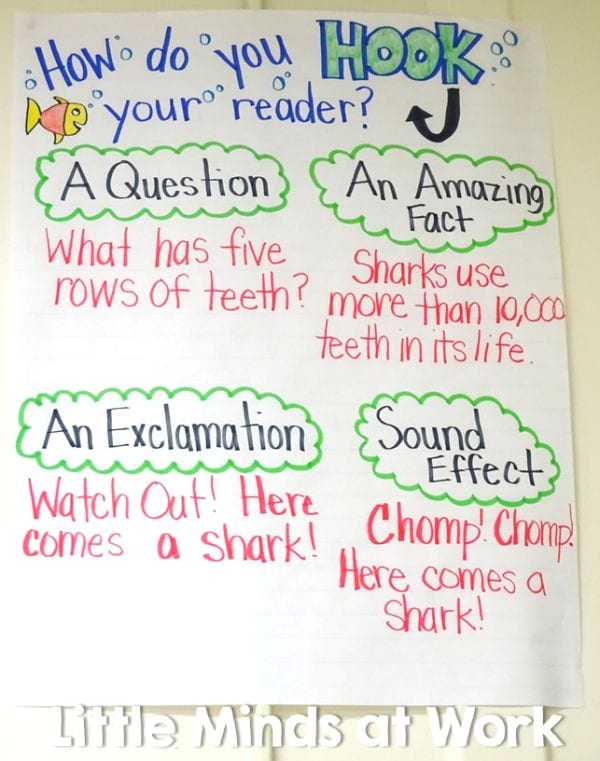
Want to know how to draw the reader in and make them eager to continue? You need a hook! Teach students how to grab a reader’s attention from the get-go, pulling them in with facts, questions, or even sound effects.
Source: Little Minds at Work
5. Point of View

Learn the differences between first person (I), second person (you), and third person (narrator), and talk about when each type is effective.
Source: Oh Boy … It’s Farley!
6. Organized Paragraph
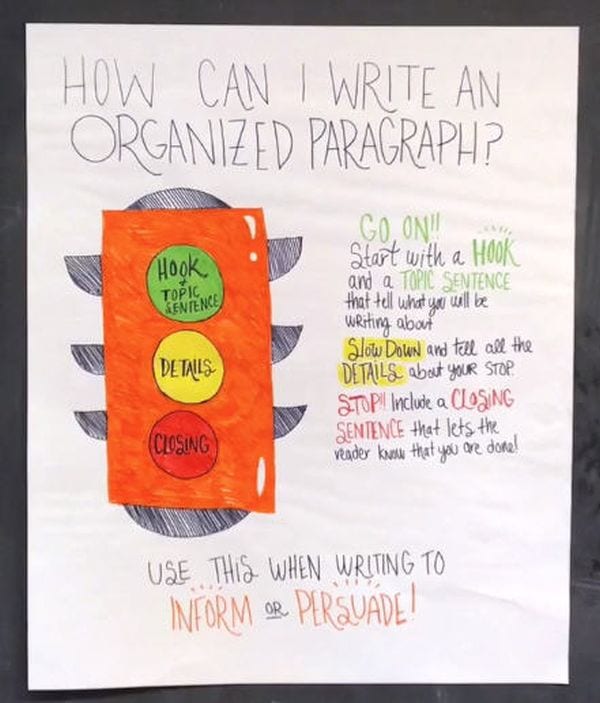
Use a stoplight to help early elementary students understand and write clear paragraphs. As students are editing their work, have them read with green, yellow, and red pencils in hand so they can see how their paragraphs are hooking and engaging readers. See a video of this chart in action here.
7. Practicing Transitions
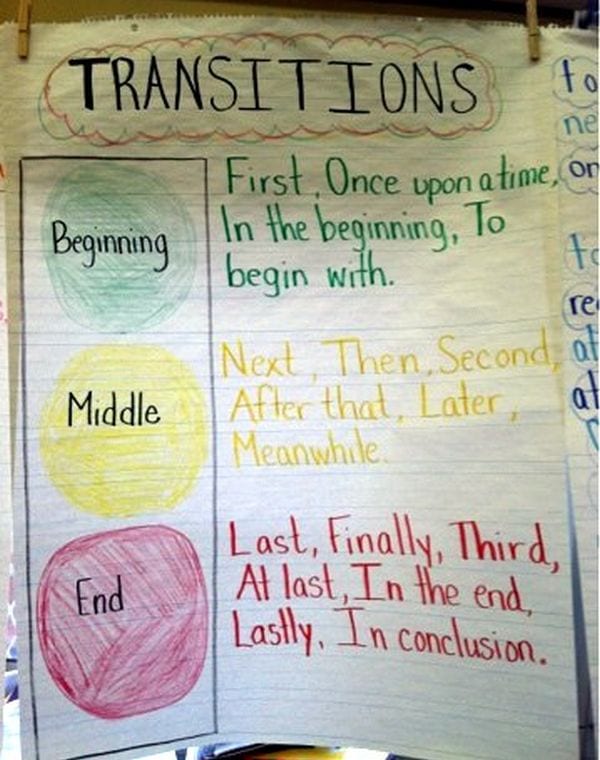
There are more stoplight writing anchor charts, and this one is perfect for helping students learn and practice their transition words. Draw the stoplight first and invite students to help come up with different words. Then encourage students to put the transition words into practice.
Source: A Happy, Hungry, Healthy Girl
8. Author’s Perspective
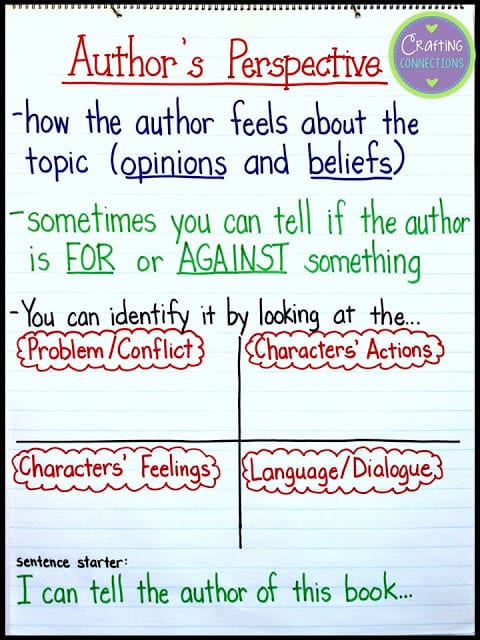
Sometimes, an author’s opinion comes out strongly in their writing, even if they don’t state it up front. Use this chart to help students find the clues to an author’s perspective.
Source: Crafting Connections/Author’s Perspective
9. Author’s Purpose Pie
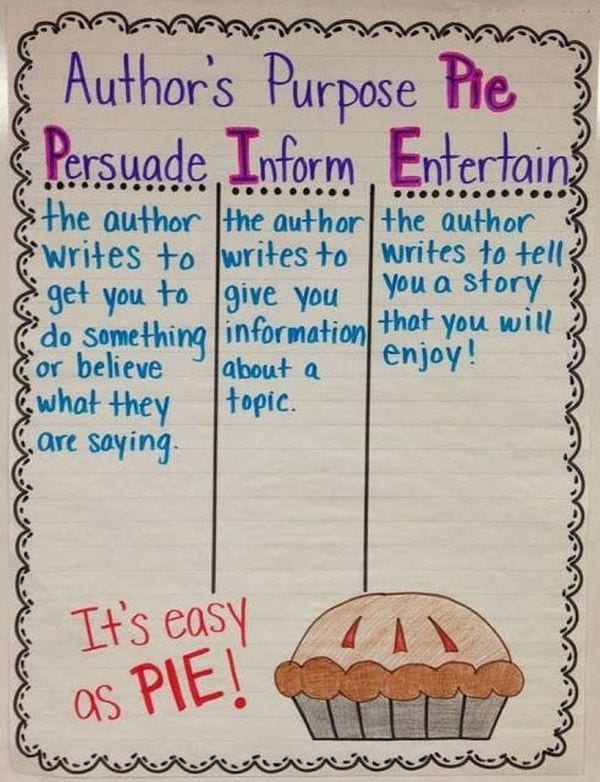
This is a quick and easy anchor chart to help students see different types of writing. It’ll also help them do a quick check to make sure their writing aligns.
Source: Literacy Ideas
10. Dig Deeper
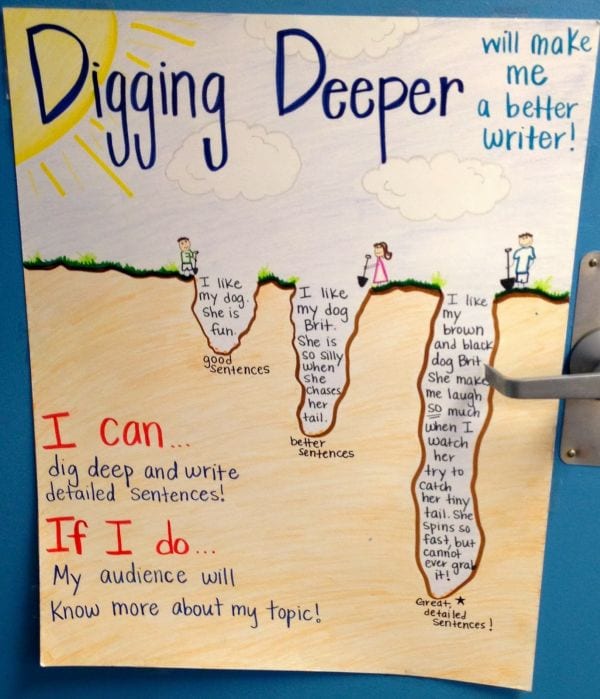
Keep going! Sometimes it’s hard to express what you mean by certain writing and revision requests, and writing anchor charts can show exactly what you mean. Now students can get a good look at what it means to dig deeper.
Source: Pinterest
11. Alternatives to “Said”
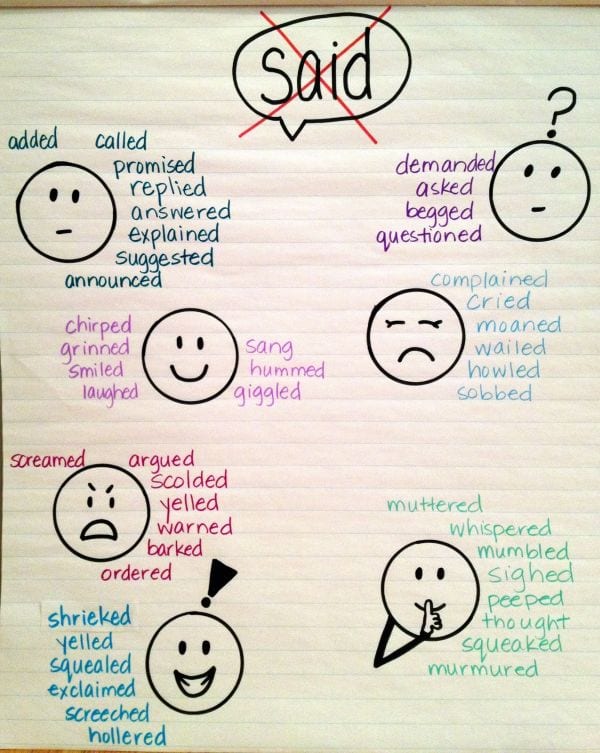
If your students are learning about writing dialogue, an anchor chart like this could really come in handy. Encourage students to try other ways to have their characters respond.
Source: ESL Amplified
12. Understanding Character
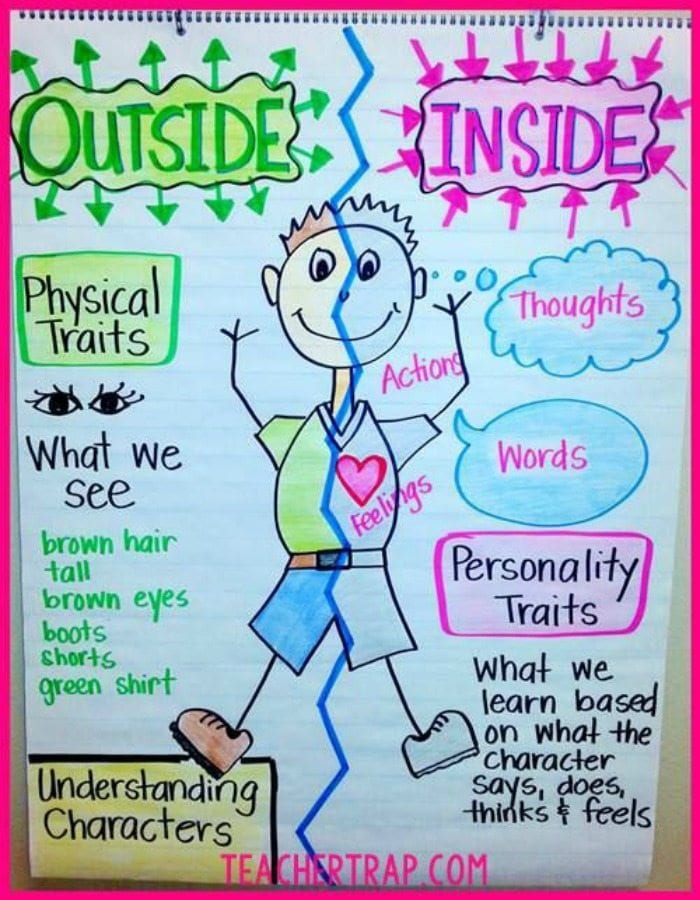
Before you can write about character, you first have to understand it. This anchor chart will help your young writers understand the difference between inside and outside characteristics.
Source: Teacher Trap
13. Diving Deeper Into Character
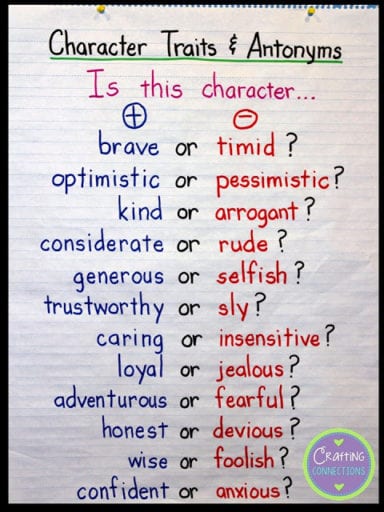
Now that your students understand the difference between inside and outside characteristics, dive deeper into describing a specific character. This anchor chart is a wonderful idea because students can write their idea(s) on a sticky note and then add it.
Source: Crafting Connections/Teach and Task Lessons
14. Six Traits of Writing
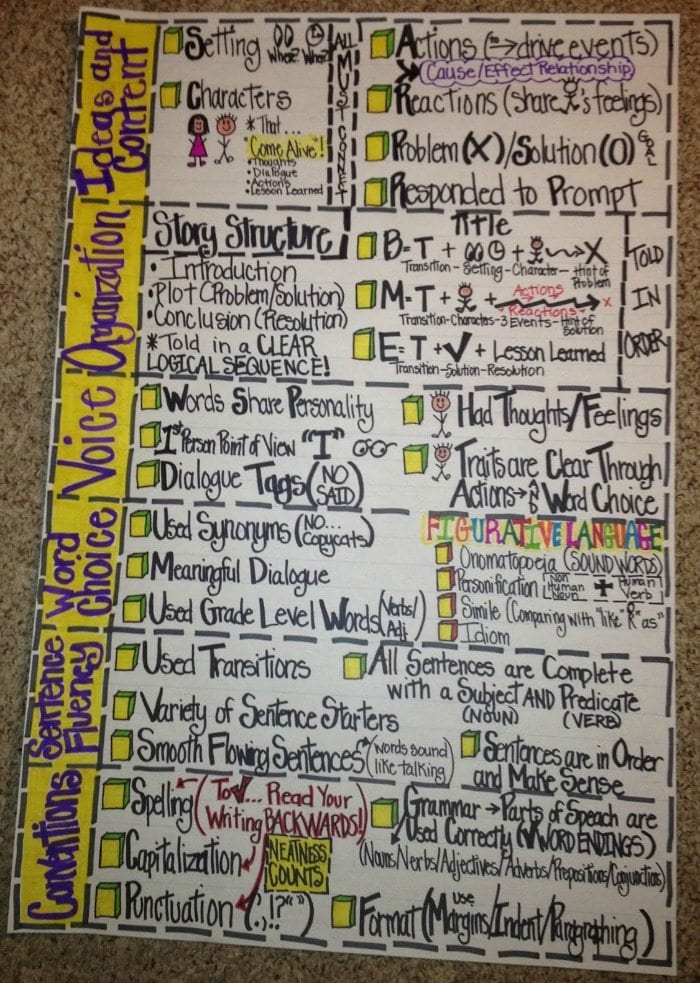
This anchor chart is jam-packed with things to help fourth- and fifth-grade writers remember the six traits of writing. Use the chart as a whole-class reference or laminate it to use in small groups. When it’s laminated, students can check off each aspect they’ve included in their own writing. Meaningful dialogue? Check! Problem and solution? Check!
Source: Working 4 the Classroom
15. Writing Realistic Fiction
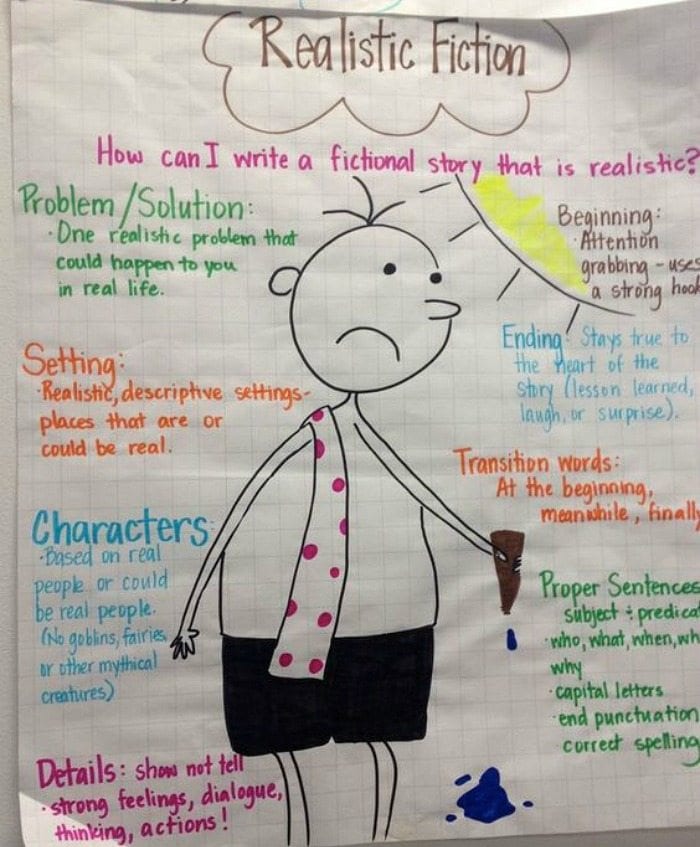
This anchor chart reminds upper elementary students how to create realistic stories. It really walks your students through the process, so they have all the elements they need to create their own stories.
Source: Two Writing Teachers/Realistic Fiction
16. Sequence of Events
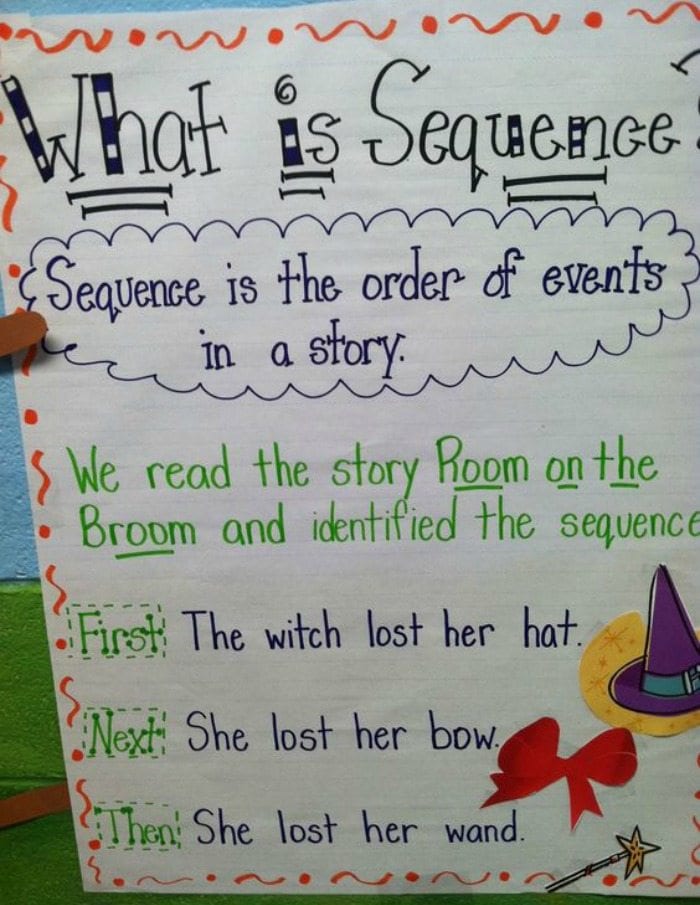
Help early elementary students stay organized with an anchor chart that’s focused on order-of-events language. Tactile learners can write their first drafts on sentence strips and use this format to put the events in order before they transcribe their work onto writing paper.
Source: Life in First Grade
17. Informational Text Structures
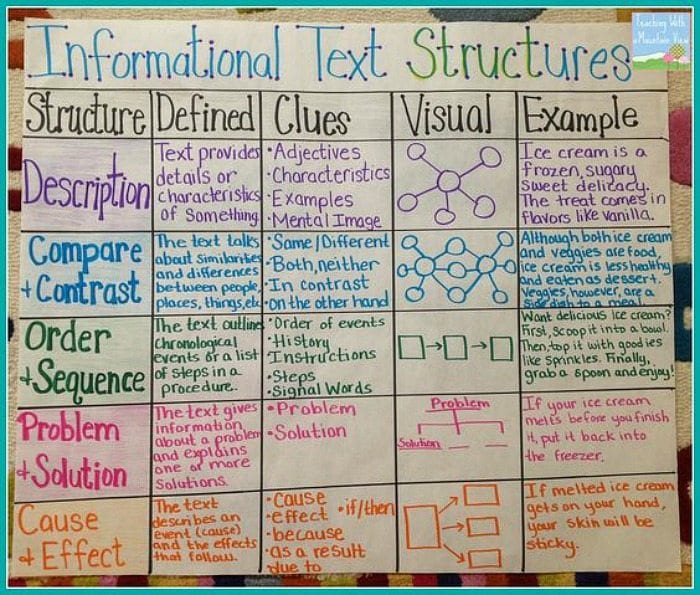
Focus upper elementary students on the most important aspects of informational writing while keeping them organized. This chart could be used to support paragraph writing or essays.
Source: Teaching With a Mountain View/Informational Text Structures
18. OREO Opinion Writing
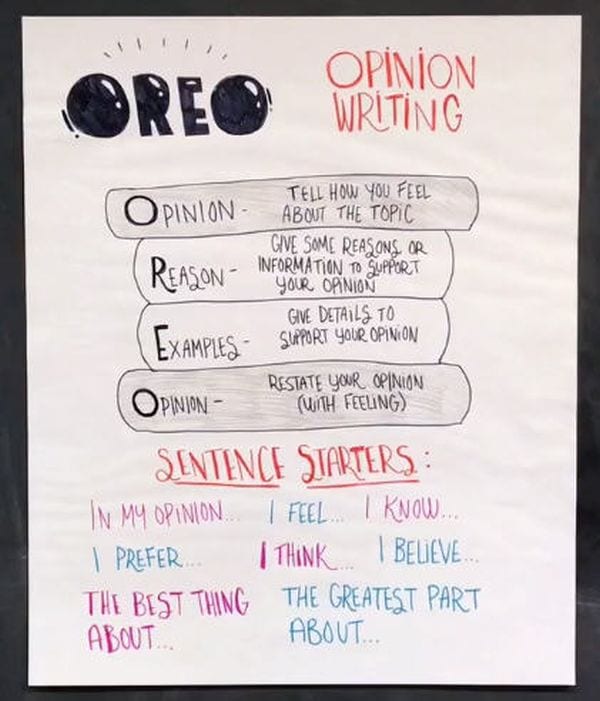
This deliciously inspired opinion anchor chart can be used by students in grades 3–5 during writers workshop or when developing an opinion for discussion or debate. To build out student writing, have them “double-stuff” their OREOs with extra E examples. See a video featuring this chart here.
19. Features of a Great Report

Use examples of outstanding student work to make this anchor chart. Keep it relevant by updating the examples with student work throughout the year. In kindergarten, this will also showcase how students move from prewriting and pictures to writing words and sentences.
Source: Joyful Learning in KC
20. Write From the Heart
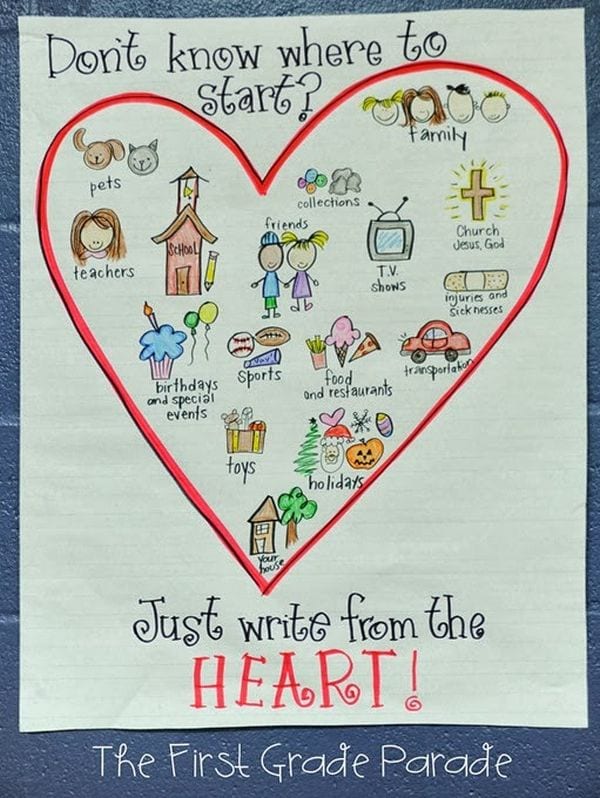
Sometimes the hardest part about writing is coming up with whom and what you should write about. This is the fun part, though! Use this anchor chart to remind your students that they have lots of good writing options.
Source: First Grade Parade via Cara Carroll
21. Argument Writing
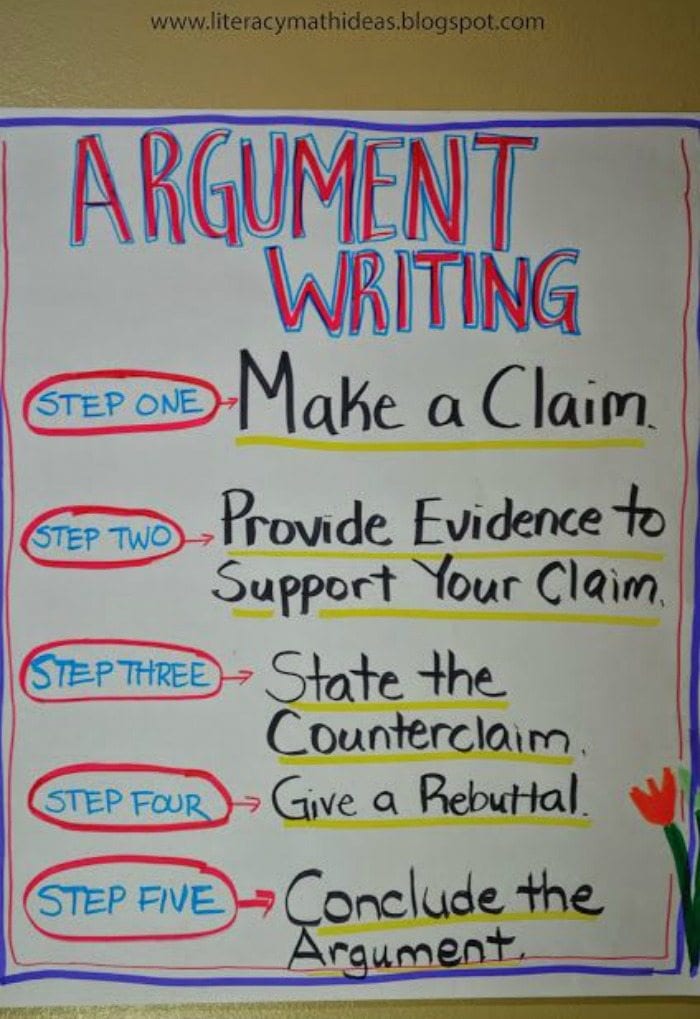
Use this anchor chart with middle schoolers to make sure they’re considering all sides of an argument, not just the one that matters the most to them. One way to adapt this chart, as students develop their understanding of argument, is to write each element—claim, argument, evidence—under a flap that students can lift if they need a reminder.
Source: Literacy & Math Ideas
22. Writing Process
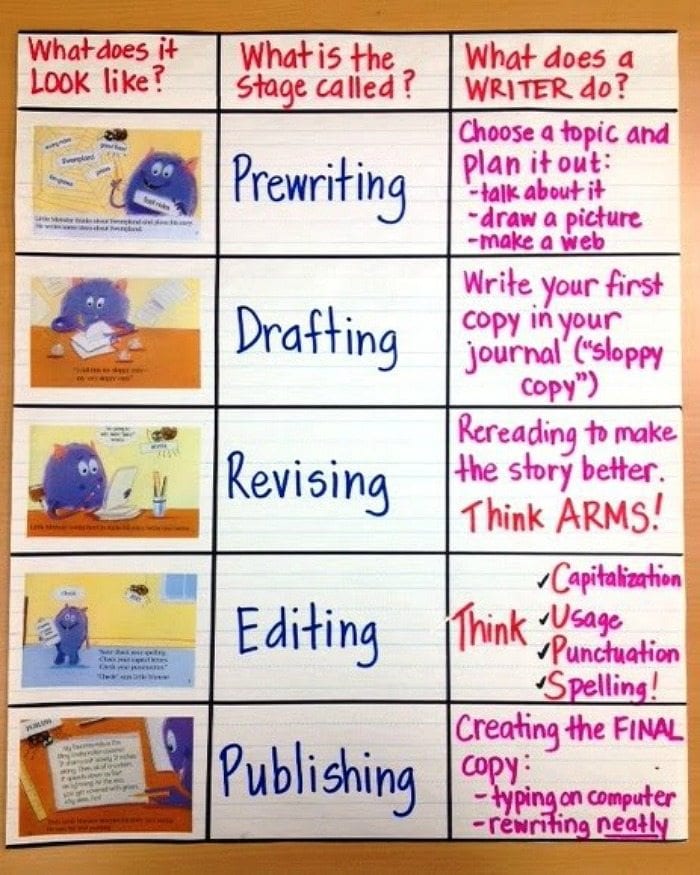
This is an anchor chart you’ll direct your students to again and again. The writing process has several steps, and it’s good to remind students of this so they don’t get frustrated.
Source: What’s Skow-ing On in Fourth Grade?
23. Writing Checklist
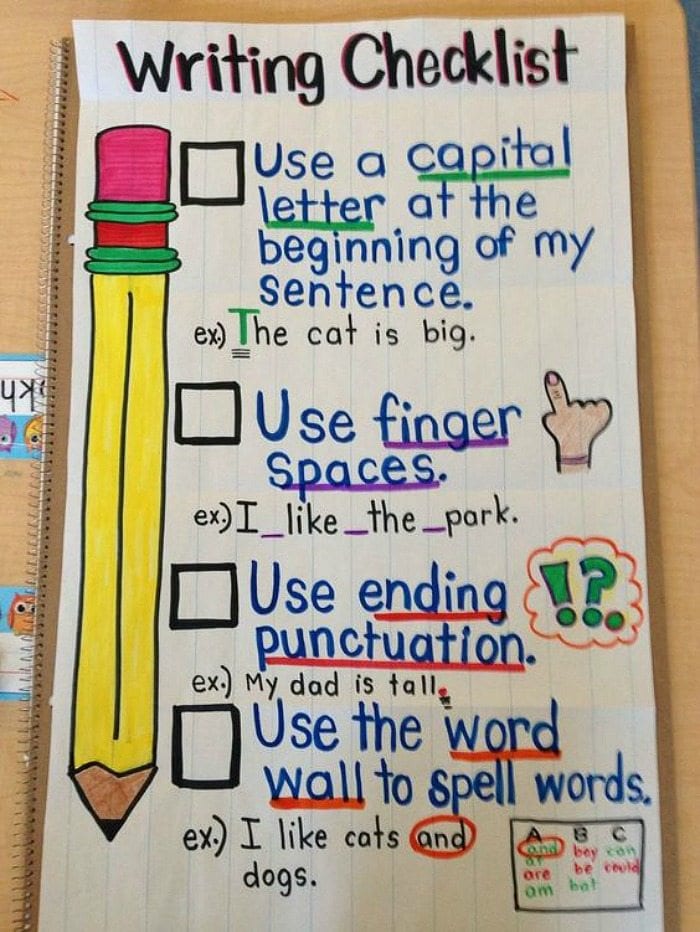
For those young writers in your class, these cover the basics in a clear way.
Source: Kindergarten Chaos
24. RACE for Writing
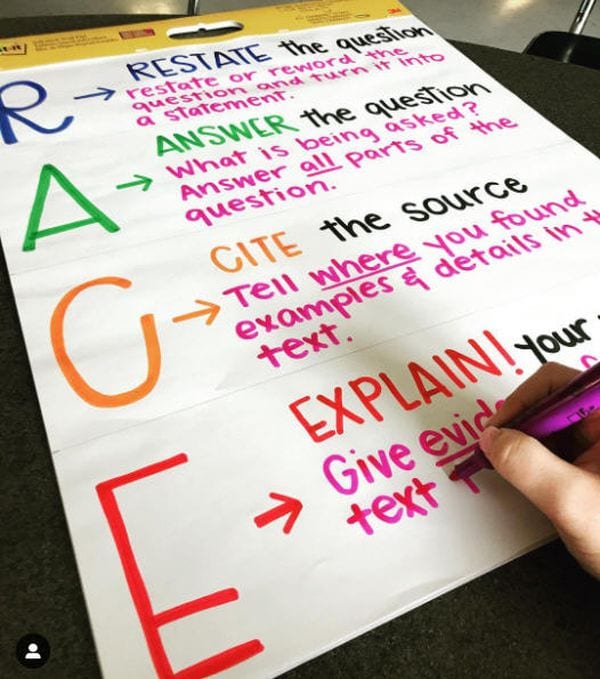
Use the RACE mnemonic when your students are working on persuasive writing. It reminds them to cite their sources and be sure to answer the question being asked.
Source: @mrspuffer
25. Cause and Effect
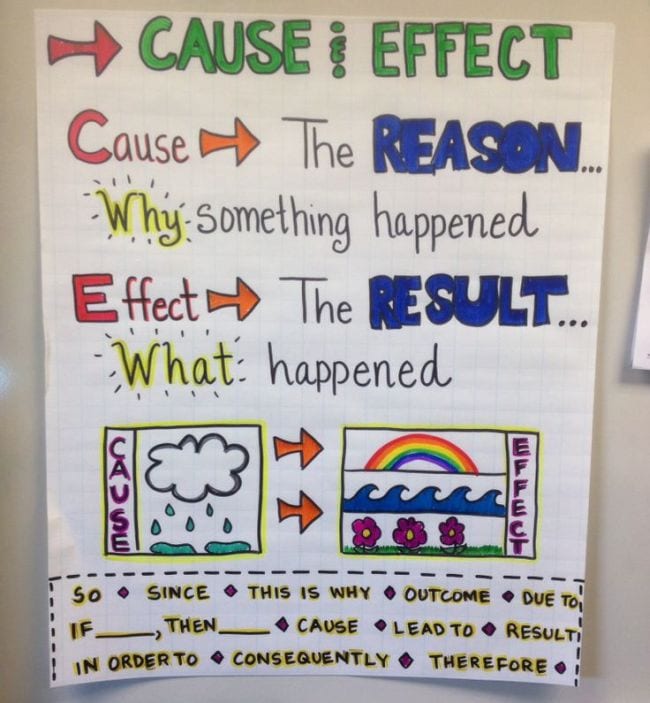
Cause and effect will always be an essential part of any story. Help your students come up with different scenarios for cause and effect. In many instances, you could have multiples effects, so challenge your students to identify three to four at a time. This will really give them something to write about!
Source: 2nd Grade Superheroes
26. A Strong Lead
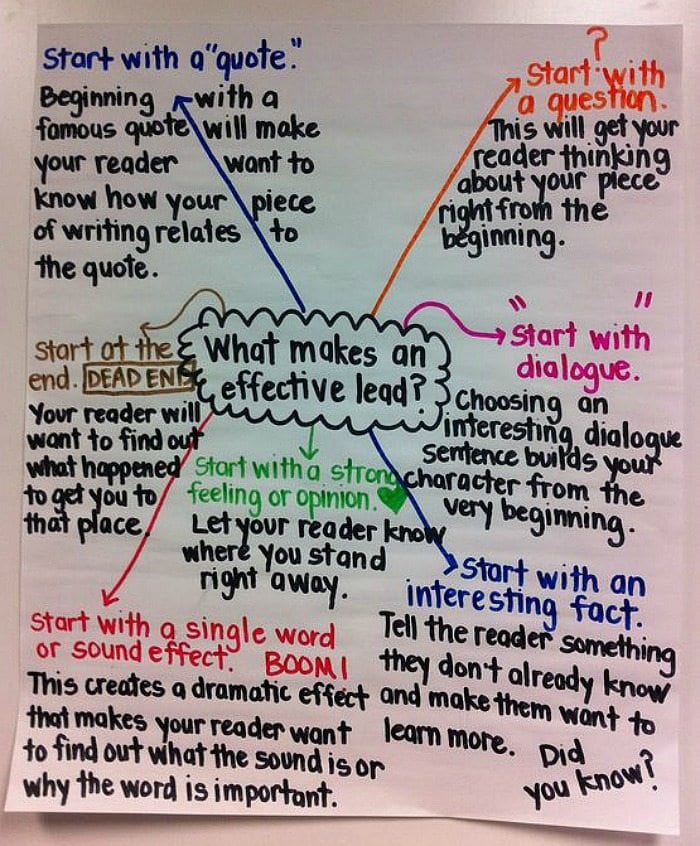
This upper-grade anchor chart gives students lots of ways to start their writing. Update it midyear with strong examples of leads that students have written or that they’ve found in books. Students could also copy this chart into their notebooks and keep track of the different ways they’ve started their own writing, seeing if they’ve developed a signature lead.
Source: Miss Klohn’s Classroom
27. Crafting Power Sentences
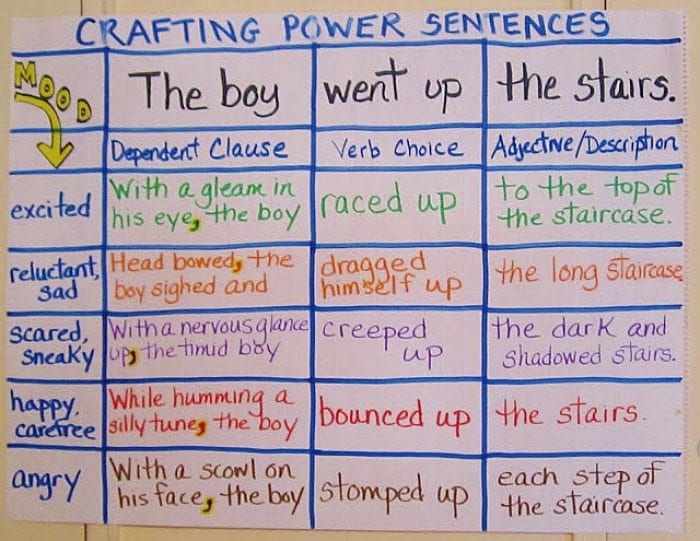
Inspire students to get crafty and creative with their sentences. Update the moods or keywords with every writing assignment, so students are constantly refining their clauses, verbs, and descriptions.
Source: Teaching My Friends
28. Show, Don’t Tell
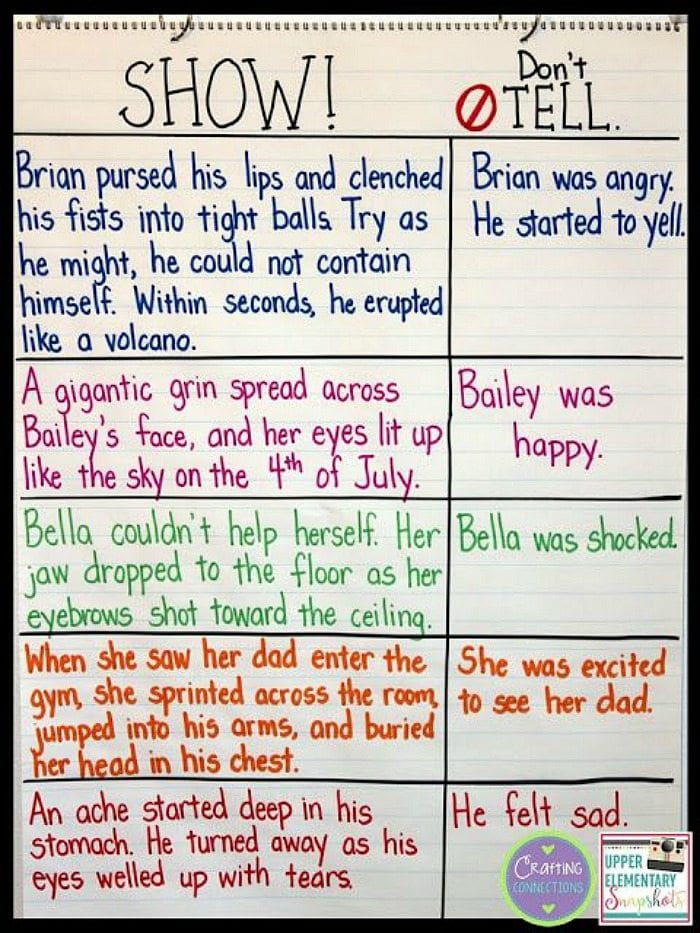
“Show, don’t tell” is a cardinal rule of writing. This anchor chart, best for upper elementary writers, can be used to strengthen scenes in fiction and narrative nonfiction works. Build out this chart for middle school writers with additional ideas and more complex emotions.
Source: Upper Elementary Snapshots/Show, Don’t Tell
29. Narrative Organizer
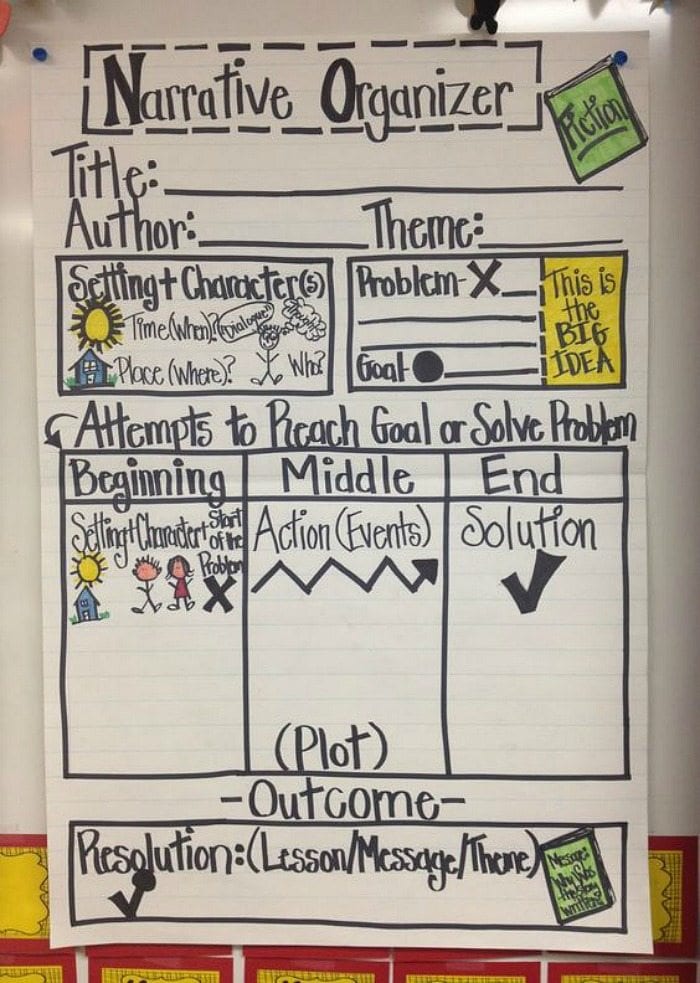
Leave this chart up in your classroom for your students to reference often when they’re writing. It really takes them through creating a successful story.
30. Expository Writing
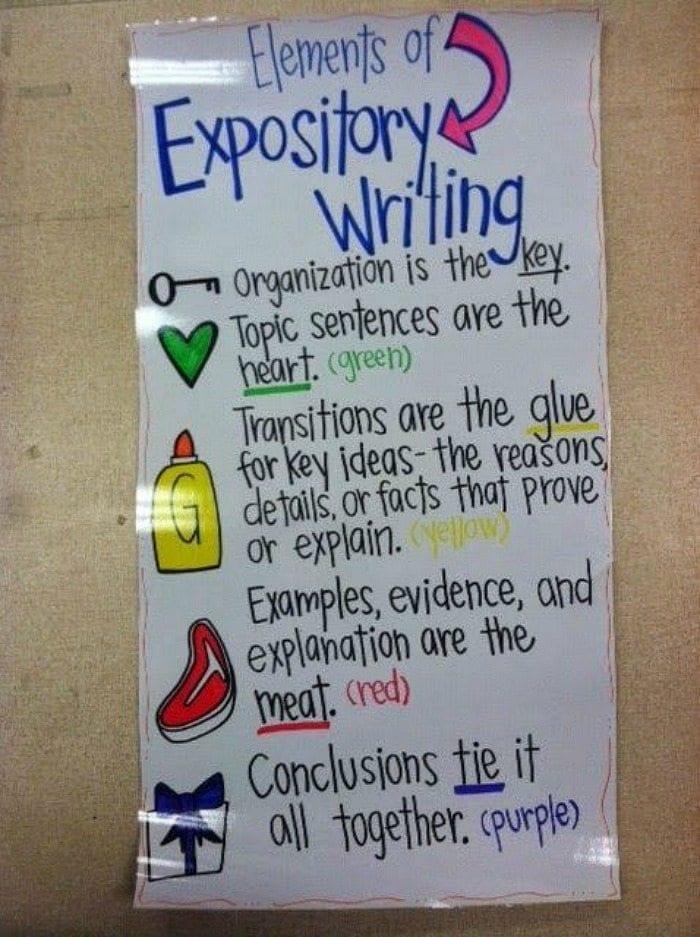
This chart makes it easy for students to remember key concepts, both with color-coding and simple metaphors. Give them colored pencils and ask them to underline the corresponding sections in their essays.
Source: Adventures of a Future Teacher
31. Peer Editing

Peer editing teaches kids a variety of skills, and not just with writing. They learn to read closely, offer (and accept) useful constructive feedback, and get more comfortable sharing their writing with others. This chart helps kids through the sometimes-challenging process.
Source: Taleof2Teachers
32. Strong Sentences
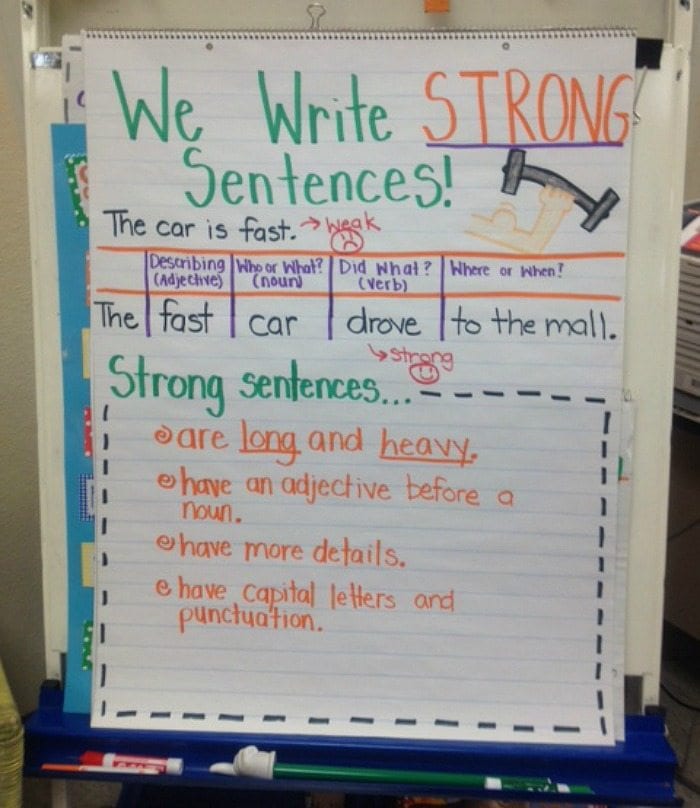
Get early elementary students to write longer, more descriptive sentences with this chart. Bonus: Use sentence strips to switch out the examples of strong sentences, based on student writing.
Source: The Good Life
33. Internal Story
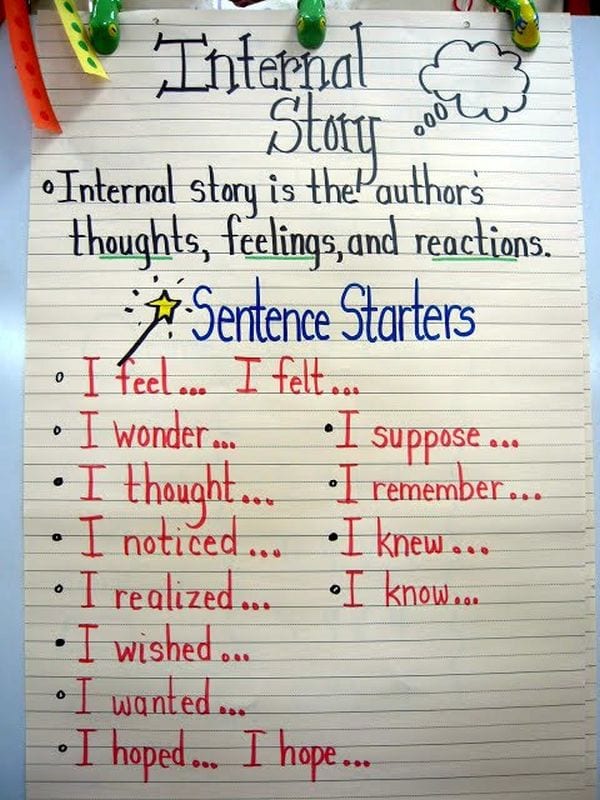
This chart gives students the language to add their own thoughts to their writing. Modify this chart by highlighting key phrases for students with special needs. Or have students create different thought-bubble icons to represent each internal dialogue sentence starter.
Source: Totally Terrific in Texas
34. Evidence Supported
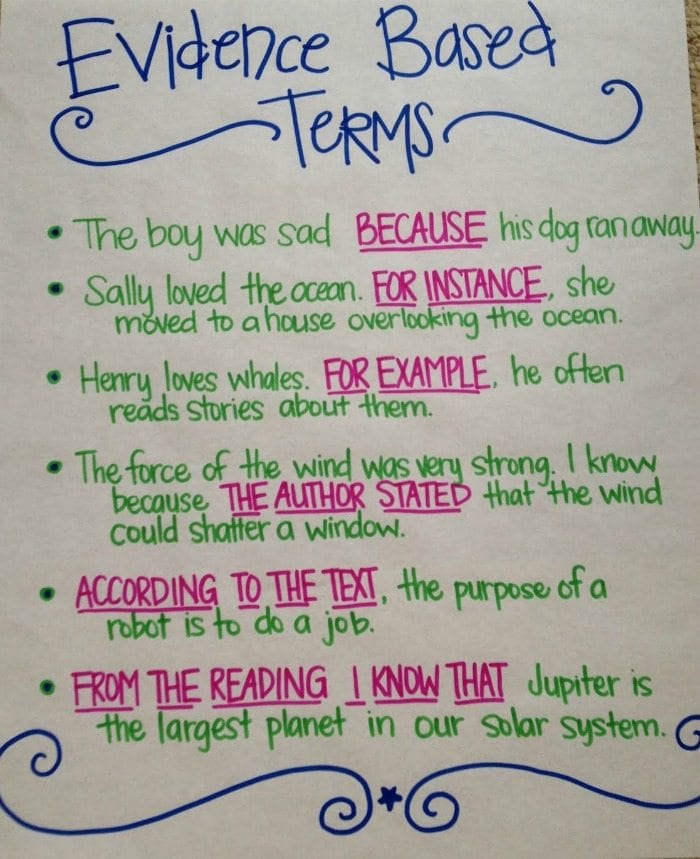
Upper elementary students will benefit from reminders on how to refer to and cite text evidence. Use this anchor chart during writing and discussion to help connect the language that we use across domains.
Source: History Tech
35. Publishing Guidelines

Kids are often quick to turn in their papers without making sure they’ve included all the necessary requirements (like their names!). Use this chart to remind them about the important things to check for before they hand in their work.
Source: Juice Boxes and Crayolas
36. Figurative Language
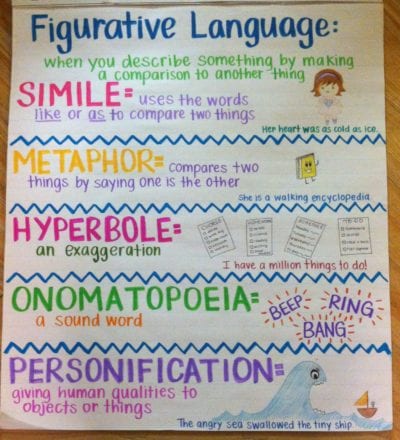
As you teach your students about figurative language and how to use it, you’ll want to have examples. This anchor chart dives into five different concepts. Each of these could actually be its own anchor chart. Perhaps have your students come up with examples on sticky notes and then place them on the chart.
Source: Willow Grove Elementary School
37. Forms of Poetry
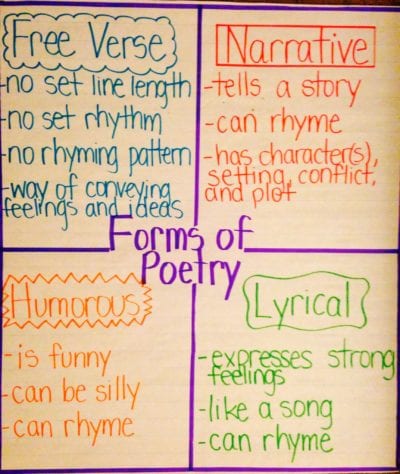
Introducing poetry types to your students? This anchor chart covers the basics and helps kids remember that not all poetry needs to rhyme.
Source: ELA Anchor Charts
38. CUPS and ARMS
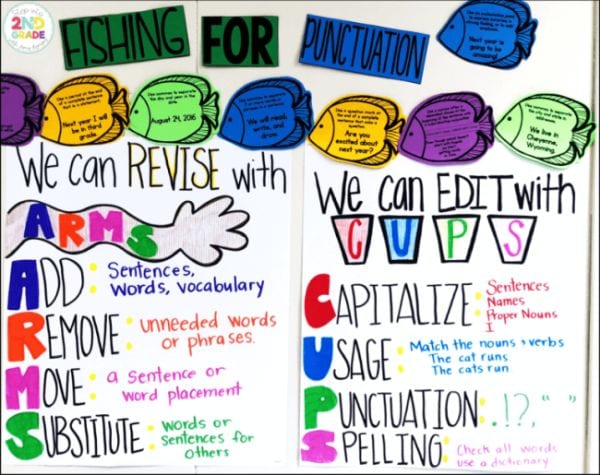
This is a popular method for teaching kids to revise and edit as well as the difference between the two. Simple acronyms keep the key strategies close at hand.
Source: Amy Lemons
39. Spicy Edits
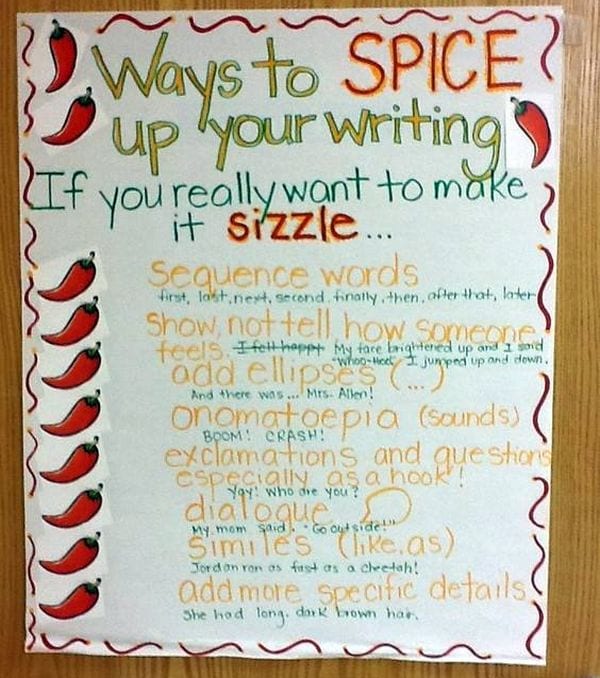
Encourage your students to think of their writing like a recipe, which they can always tweak and improve. Have them choose one element, or “spice,” to add to their work as they revise.
Source: Beyond Zebra/Pinterest
40. Writing Buddies
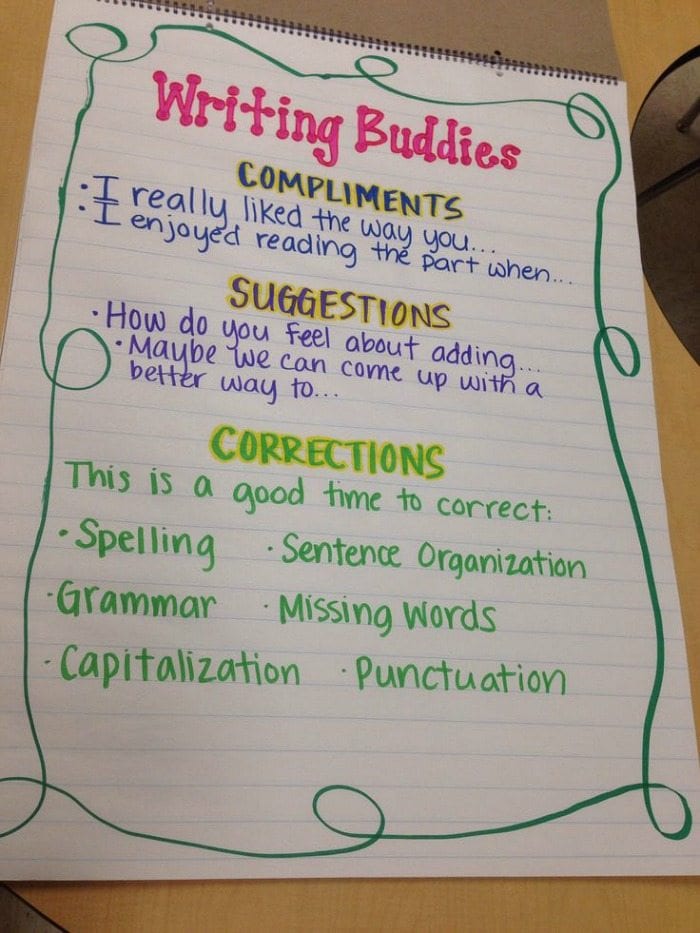
Sometimes students can get stuck when working with writing buddies, but writing anchor charts can help. This one encourages students to be positive and make good, thoughtful suggestions.
Source: Apostrophe Books Twitter
What are your favorite writing anchor charts? Share your ideas in our WeAreTeachers HELPLINE group on Facebook.
Plus, find out why the “hamburger” essay has gone stale, and what to try instead ..
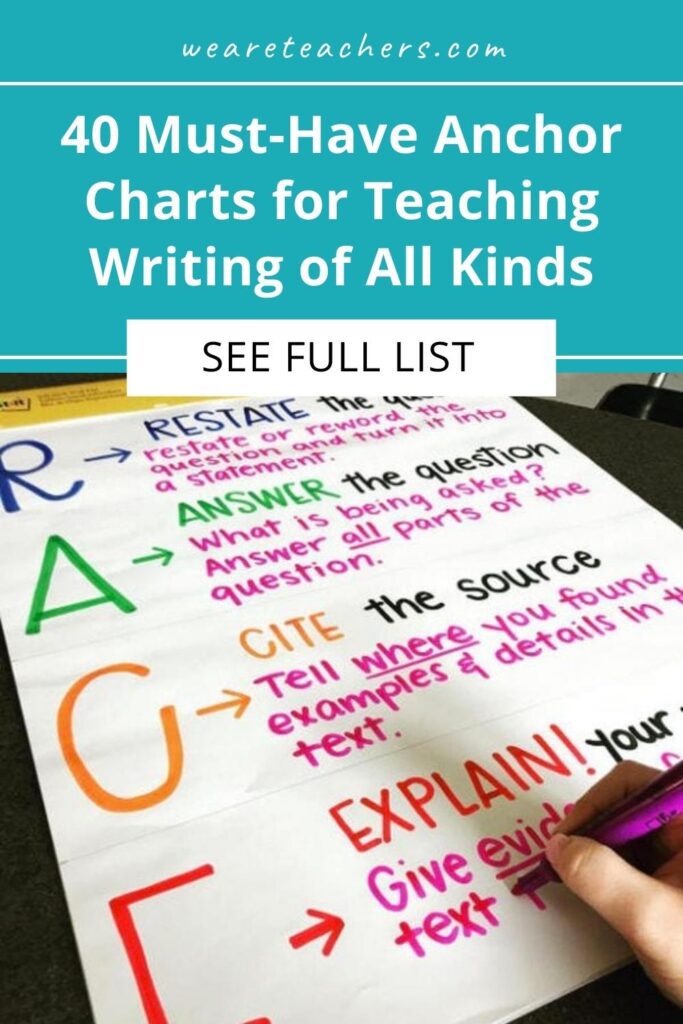
You Might Also Like
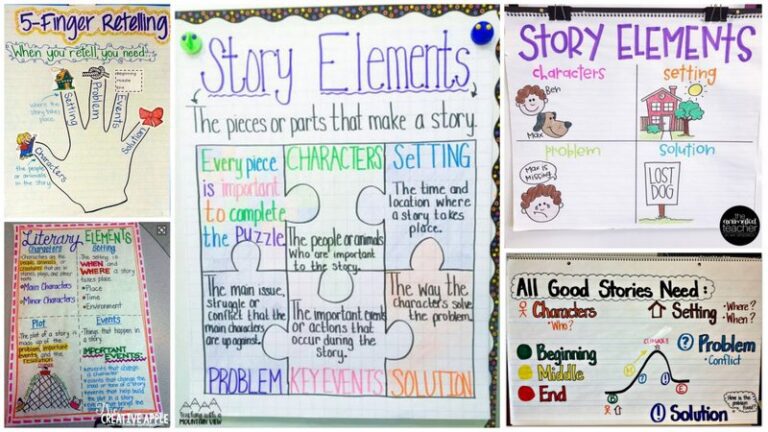
15 Clever Anchor Charts for Teaching Story Elements
All the pieces that make up a story. Continue Reading
Copyright © 2023. All rights reserved. 5335 Gate Parkway, Jacksonville, FL 32256
- Skip to main content
Join All-Access Reading…Doors Are Open! Click Here
- All-Access Login
- Freebie Library
- Search this website
Teaching with Jennifer Findley
Upper Elementary Teaching Blog
Teaching Persuasive Writing with a Mentor Text
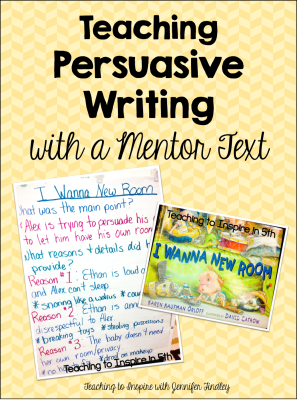
I absolutely love teaching persuasive writing, and I love using mentor texts even more. This year, I used the picture book, I Wanna New Room . This read aloud follows the same format of I Wanna Iguana with letters back and forth from the child to the parents.

My main focus for this lesson was on choosing a main point and providing valid resources to support that point. I also wanted to focus on how details are needed to support each reason given. After the read and enjoyed the book once, we created this anchor chart, using the examples from the text.
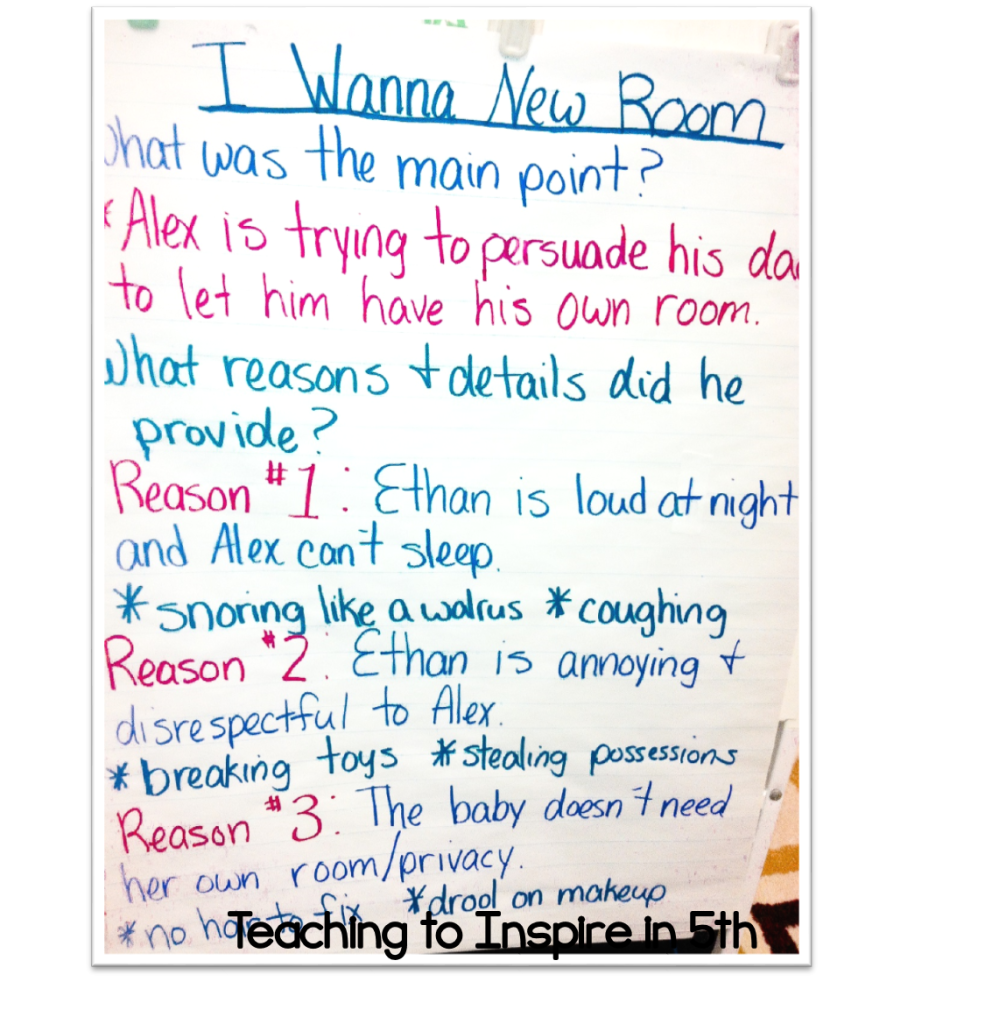
After discussing the book, we were able to come up with three reasons with each reason having two details to support it. This was a great starting point for the students to come up with 3 reasons with supporting details for their own persuasive texts. I refer to this anchor chart often to remind the students that a good persuasive text has a clear main point, three reasons, and supporting details to support the reasons.
Share the Knowledge!
Reader interactions.
September 19, 2014 at 5:39 pm
Great example of picking apart a text and using it as a model!
September 21, 2014 at 5:57 pm
I use My Lucky Day and The a True Story of the Three Pigs
October 19, 2014 at 10:04 pm
In the past I have used Click, Clack, Moo! I love your anchor chart.
Kim Quinnessential Lessons
Leave a Comment Cancel reply
Your email address will not be published. Required fields are marked *
Notify me of follow-up comments by email.
Notify me of new posts by email.
You may also love these freebies!
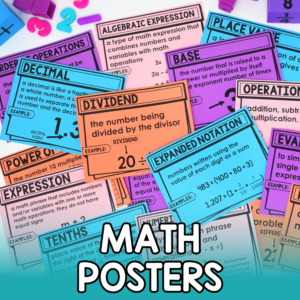
Math Posters
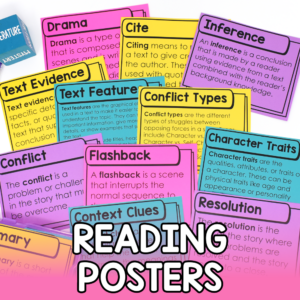
Reading Posters
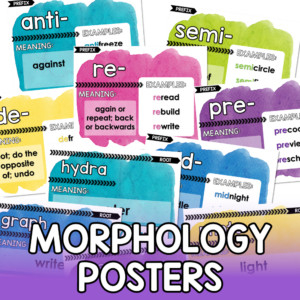
Morphology Posters
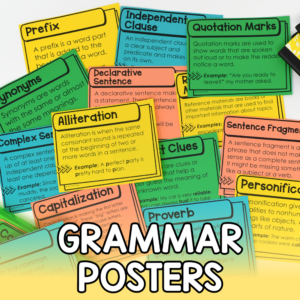
Grammar Posters

Welcome Friends!
I’m Jennifer Findley: a teacher, mother, and avid reader. I believe that with the right resources, mindset, and strategies, all students can achieve at high levels and learn to love learning. My goal is to provide resources and strategies to inspire you and help make this belief a reality for your students.
Persuasive Writing Structure Anchor Chart
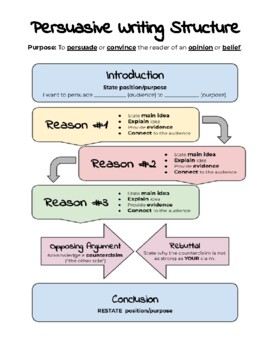
Description
A simple, easy-to-read anchor chart to help students visualize how they should structure their persuasive letters, essays, etc. I personally used this anchor chart when teaching my sixth-grade English students to write a persuasive letter to their principal.
Questions & Answers
Señora sydney.
- We're hiring
- Help & FAQ
- Privacy policy
- Student privacy
- Terms of service
- Tell us what you think

IMAGES
VIDEO
COMMENTS
Here are some of my favorite persuasive writing anchor charts that I have used to help my struggling writers write strong, detailed persuasive papers. ... Then they restate their main point and end their essay. I also offer a few suggestions with ways to end the paper. ... I am currently teaching 6th grade math at a middle school, but am ...
Anchor Charts for Persuasive Writing. Children's sense of fairness provides powerful motivation for persuasive writing. In this mini-lesson, an analysis of this genre and a graphic organizer help students succeed. This clip is excerpted from Stenhouse Publishers' "Inside Notebooks." Top.
The chart also serves as a reminder they can turn to when writing their essay. A writing anchor chart can focus on different elements of writing, but you should always start with the ones that focus on the structure, such as: ... Demonstrate persuasive writing. ... 1st Grade Teaching Resources (29) Anchor Charts (45) Bulletin Boards (50) Career ...
Below, are some ways you can use opinion writing anchor charts to give 4th and 5th grade students tangible examples of how to make their writing focused, well-supported, and engaging. 1. Opinion Writing Hooks. Once students have a plan of action for their writing, introducing a writing "hook" is a natural place to begin when starting ...
This free persuasive writing unit of study is designed to fit into your 1st, 2nd or 3rd grade writing workshop. Download this persuasive writing unit of study to help you plan an engaging and effective unit in your classroom. This unit contains anchor charts, graphic organizers and lessons to help you create the perfect unit for your students.
Norman, Elle V., "Tell Me Why: A Persuasive Writing Unit for 4th-6th grade" (2018). Understanding by Design: Complete Collection. 412. This Instructional Material is brought to you for free and open access by the Understanding by Design at Digital Commons @ Trinity. For more information about this unie, please contact the author(s ...
The Importance of Anchor Charts These charts are created as a result of a joint effort between the teacher and the students. They are not created ahead of time. As the teacher models the strategy, it is recorded using a variety of media (chart paper, journals, electronic presentations), along with any tips or advice to help
The Persuasion Map is an interactive graphic organizer that enables students to map out their arguments for a persuasive essay or debate. Students begin by determining their goal or thesis. They then identify three reasons to support their argument, and three facts or examples to validate each reason. The map graphic in the upper right-hand ...
Writing Effective Counterclaims. Worksheet. Household Chores: Opinion Writing Exercise. Worksheet. Respond to Art: Opinion & Evidence #1. Worksheet. 1. Browse Printable 4th Grade Persuasive Essay Structure Worksheets. Award winning educational materials designed to help kids succeed.
Description. This anchor chart breaks down how to write a persuasive essay. It's a quick reference for students. It also helps educators explicitly teach how to decode a prompt and outlines each portion of a well-written opinion essay. (Suggested print option: In Adobe Acrobat, tile all pages at 200% with an overlap of .3.
Anchor charts are a great way to make thinking visible as you record strategies, processes, cues, guidelines and other content during the learning process. Here are 25 of our favorite charts for teaching your students all about writing. 1. The Why Behind Writers Workshops Source: The First Grade Parade. First and second graders will draw ...
My fourth grade opinion writing unit includes 8 weeks of done-for-you writing lessons about how to write a strong opinion essay.This unit contains detailed lesson plans, mentor texts, anchor charts, student writing tasks, and rubrics -everything you need to be a capable, confident writing teacher with students who love to write.. If teaching writing has ever made you cry, weep, tear out your ...
4th Grade 48. 5th Grade 42. 6th Grade 19. 7th Grade 1. More filters. Location United States availability . Premium 59. ... Get students using emotive language examples in their persuasive essays with this differentiated cloze passage worksheet. ... Rhetorical Devices Anchor Charts
6-week sequence for successful teaching and learning of a new writing type (genre). This basic 6-week plan includes modeling, shared and guided writing, revision and editing, and finally sharing, publishing, and a dress rehearsal for on-demand assessment.
4. Prepositions. Grammar is a good time for an anchor chart! This one uses mice to help students better understand the meaning of prepositions and comes from The Teacher Next Door. 5. Sentence structure. Even in fourth grade, students can use a few reminders about writing good sentences.
This anchor chart is a wonderful idea because students can write their idea(s) on a sticky note and then add it. Source: Crafting Connections/Teach and Task Lessons. 14. Six Traits of Writing. This anchor chart is jam-packed with things to help fourth- and fifth-grade writers remember the six traits of writing.
After discussing the book, we were able to come up with three reasons with each reason having two details to support it. This was a great starting point for the students to come up with 3 reasons with supporting details for their own persuasive texts. I refer to this anchor chart often to remind the students that a good persuasive text has a ...
This resource includes: - persuasive writing anchor chart using OREO (opinion, reason, examples, re-state opinion) - sentence starter poster. - rough draft worksheet. - good copy paper (in 3 different line sizes for differentiation) - persuasive writing rubric. This product is a printable resource and digital through EASEL for easy sharing in ...
Opinion Writing - 3rd Grade; Use this opinion writing anchor chart as an early-in-the-year review of the components of opinion writing. Have students begin with an opinion letter, as shown in the opinion writing example, then transition into opinion essay writing. Make sure to check the catalog for more anchor charts for writing.
Description. This persuasive writing FREEBIE is modeled after the OREO method, but with an added component. Strengthen your upper elementary and middle school students' writing by making sure they understand all the steps to this writing style. Full page chart or smaller 1/4 page for interactive notebooks. ORE-REO.
MLT - MajorLeagueTeacher. This resource includes; Anchor Chart outlining the text structure and language features of persuasive texts (3 versions) Cut, Sort and Glue Activity (2 versions)Checklist for students to check then attach to their persuasive texts when editing their written work. Subjects: Informational Text, Writing. Grades: 1 st - 6 th.
MEGA BUNDLE: PERSUASIVE WRITING. This is a MEGA-BUNDLE that includes everything you will need to successfully teach your students how to understand and write successful PERSUASIVE texts. My own Year Three students LOVE all of these resources and GO back to them s reference points throughout the year. It includes stand-alone resourc. 8. Products.
4th. 5th. 6th. 7th. 8th. 9th. 10th. 11th. 12th. All Subjects. Subject. Arts & Music. ... A simple, easy-to-read anchor chart to help students visualize how they should structure their persuasive letters, essays, etc. I personally used this anchor chart when teaching my sixth-grade English students to write a persuasive letter to their principal.